Design Awards 2016: best of the rest
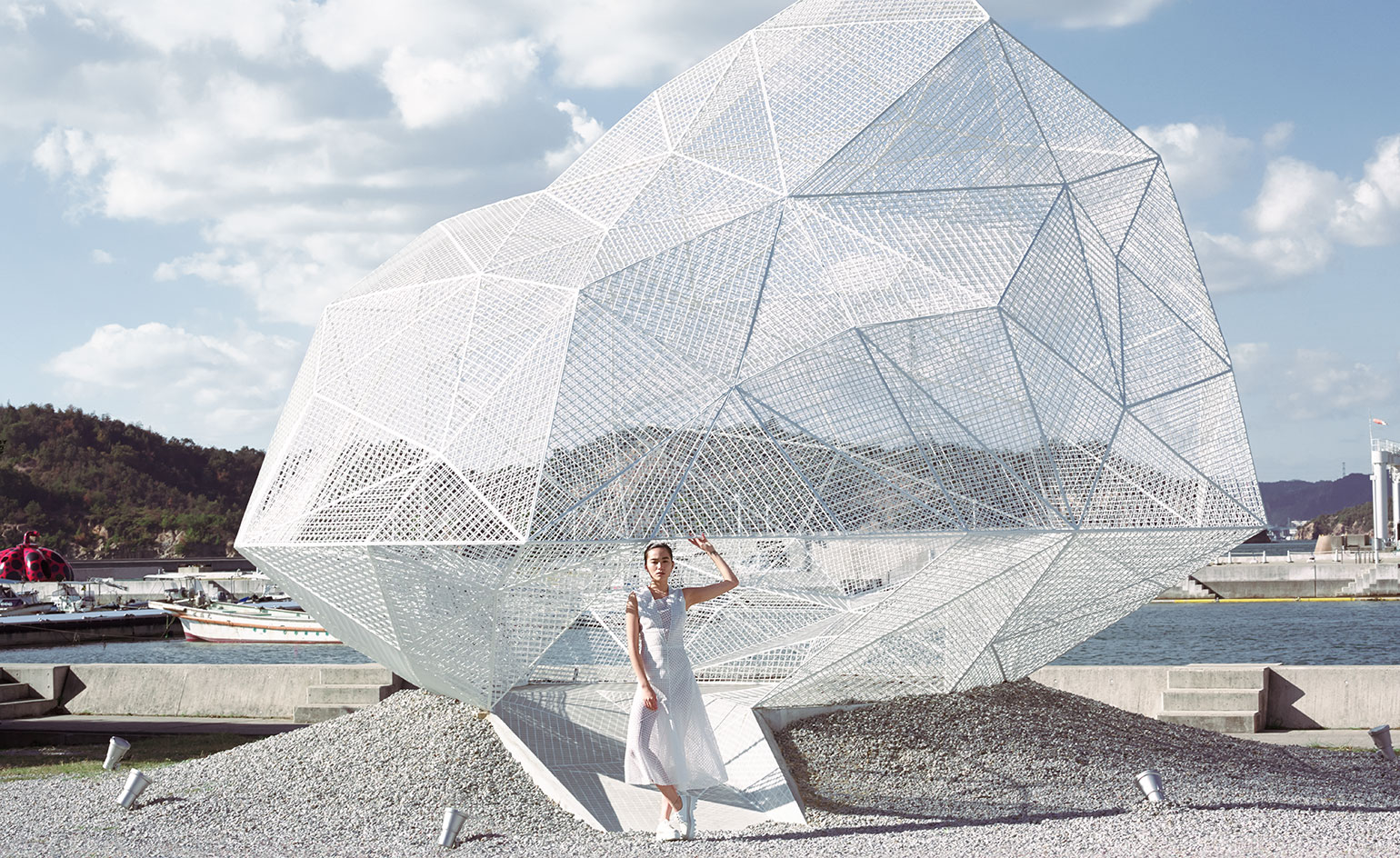
Best Alliance
S/S16 womenswear collection, by Akris, inspired by the work of Sou Fujimoto
We’re accustomed to being wowed by high-production catwalk shows and sets. Chanel recreates full-scale airports and supermarkets; Marc Jacobs colonises famous Broadway theatres; and Louis Vuitton has parked real trains in the middle of the catwalk. But not many designers go to the lengths of Akris’ creative director Albert Kriemler, who recreated a life-sized section of Sou Fujimoto’s House N at his show last season in Paris. He then designed an entire collection of clothes inspired by Fujimoto’s architectural principles. Kriemler is a hardcore art and architecture buff, a passion he indulges with academic rigour rather than champagne-soaked socialising. He spent many hours studying Fujimoto’s output and visiting his geometric Naoshima Pavilion, on Naoshima Island in Kagawa Prefecture, before engineering a meeting with the Japanese architect through architectural photographer Iwan Baan. Fujimoto readily accepted the invite to collaborate and was on hand at the fashion show (his first) as many of his most intriguing works, including the Serpentine Pavilion in London and the House of Hungarian Music in Budapest, as well as his House N and Naoshima Pavilion, all showed up on Kriemler’s painstakingly created, custom-developed fabrics. Dresses made of thin strips of cork resembled wood panels, pebble-shaped holes pierced shirts like windows, and metallic dresses imicked silver houses. As for the set, a group of Swiss artisans were imported from the green hills of St Gallen, where Akris is based, to faithfully reconstruct a portion of House N (which is actually in Ōita, southern Japan), in just six hours inside Paris’ Grand Palais. Now that’s what we call Swiss efficiency.
Pictured: on location at Sou Fujimoto’s Polyhedral Naoshima Pavilion, on Naoshima Island. Dress, £3,180; shoes, price on request, both by Akris
Photography: Takahito Sasaki; Writer: JJ Martin
As originally featured in the February 2016 issue of Wallpaper* (*203)
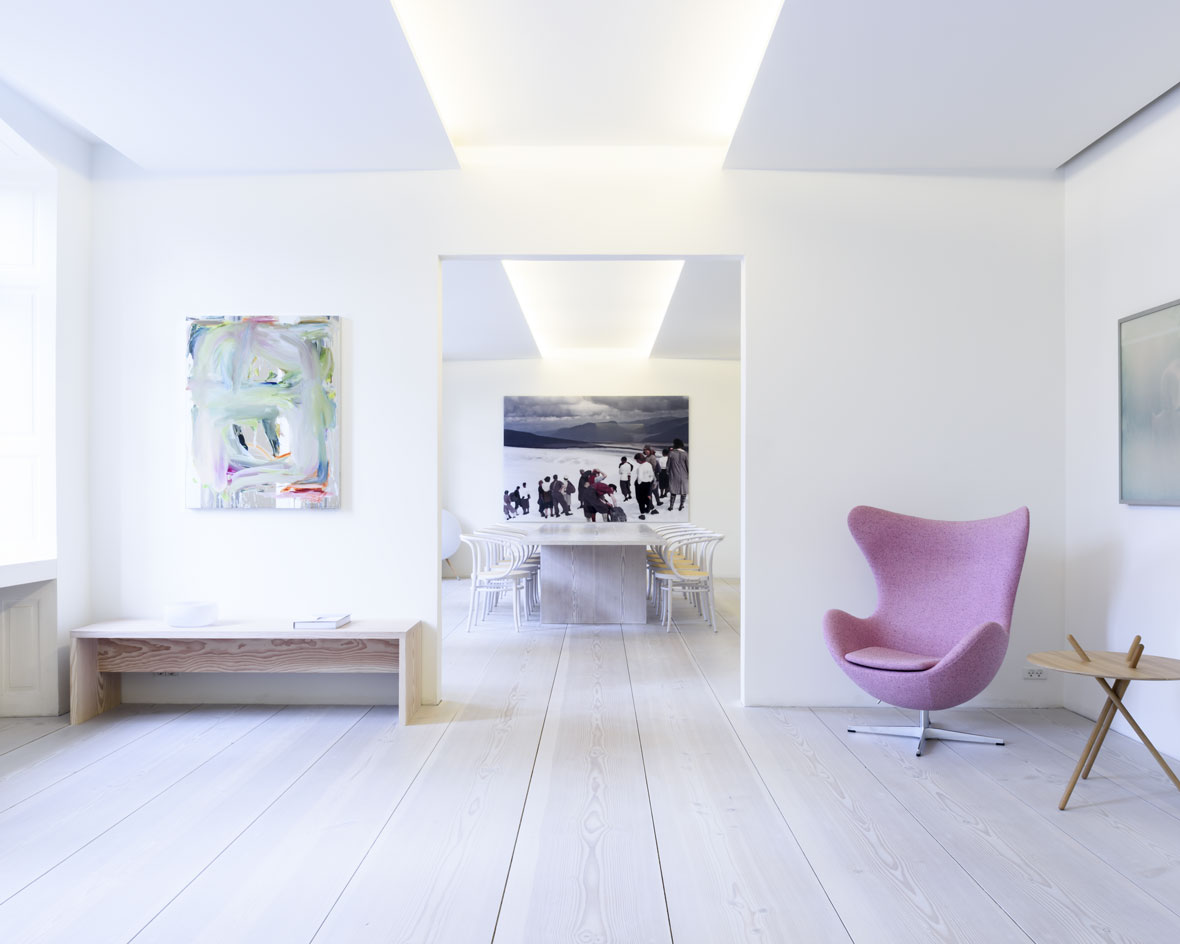
Best Apartment
By Dinesen, Copenhagen
You won’t find this apartment on Airbnb – although you can stay here if you happen to be a lucky client of the Danish flooring company Dinesen. The apartment is a shrine to Scandi modernism and the silken beauty of the Douglas fir. Originally designed by Anouska Hempel for a private client in 2003, it has always featured Dinesen’s trademark, extraordinarily wide planks of lye- and white soap-finished wood.
Now the company has added bespoke bookshelves and furniture crafted from the same Black Forest trees as the floorboards – including a table treated with Paris Blue linseed oil. On the walls are paintings by contemporary Danish artists, including the abstracts of Peter Bonde and the hyper-real ‘found’ photography of Ebbe Stub Wittrup over the Dinesen-plank dining table. The art looks down on several other collector’s pieces, including an Arne Jacobsen ‘Egg’ chair in Raf Simons’ fabric for Kvadrat, and a ‘PK9 Tulip’ chair by Poul Kjærholm. No need to bring your own towels – they’re by Georg Jensen Damask.
Pictured: Danish art on show includes works by Peter Bonde (left) and Ebbe Stub Wittrup (centre)
Photography: Alastair Philip Wiper; Writer: Paul McCann
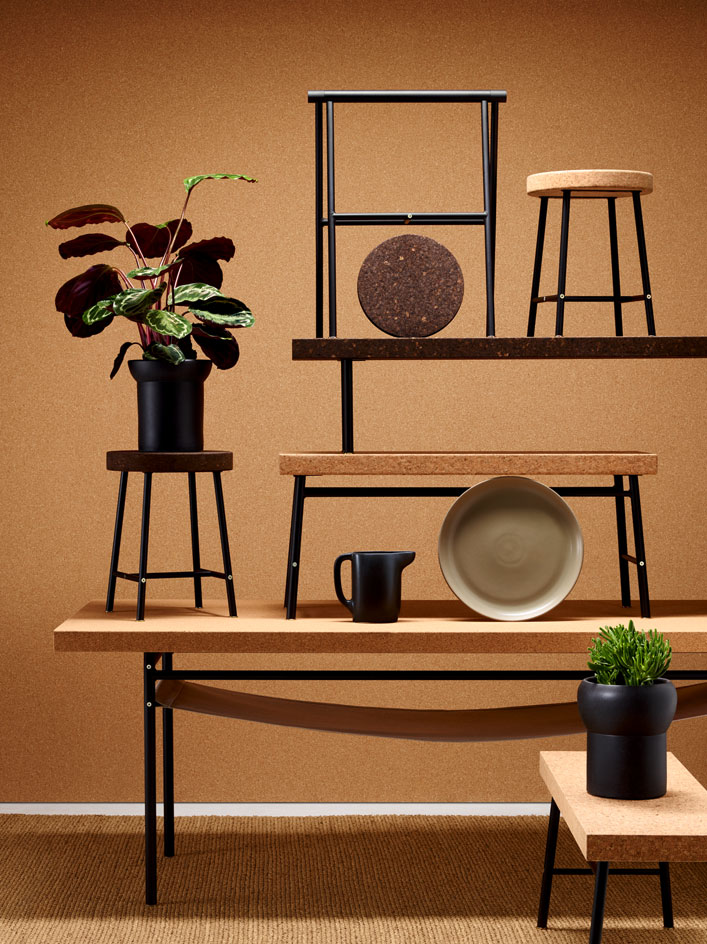
Best Basics
Sinnerlig collection, by Ilse Crawford, for Ikea
British designer Ilse Crawford is known as a master of understatement. Leave it to her, then, to bring elegant restraint to the display sets of Swedish furniture giant Ikea. Crawford’s Sinnerlig collection for Ikea comprises more than 30 pieces of furniture, accessories and lighting in natural materials – such as cork, jute, bamboo and seagrass – combined with glass, ceramic and powder-coated steel. With an emphasis on sustainable production, the pieces are practical, tactile and beautifully simple everyday staples.
From top, trestle, £135 for two trestles and a table top; Pot Stand in dark brown cork, £9; Stool in natural cork, £50; Coffee table in dark brown cork, £50; Plant Pot, £7; Stool in dark brown cork, £50; Bench in natural cork, £50; Jug, £5.50; Serving plate, £9; Dining table in natural cork, £250; Plant Pot, £7; Bench in natural cork, £50; Flatwoven Seagrass rug, £50, all part of the Sinnerlig collection, by Ilse Crawford, for IKEA. Calathea plant, £8; Succulent Plant, £3, both from IKEA. Natural cork wall covering, from £21.20 a roll, from SPD UK, Spduk.co.uk
Photography: Michael Bodiam; Writer: Rosa Bertoli
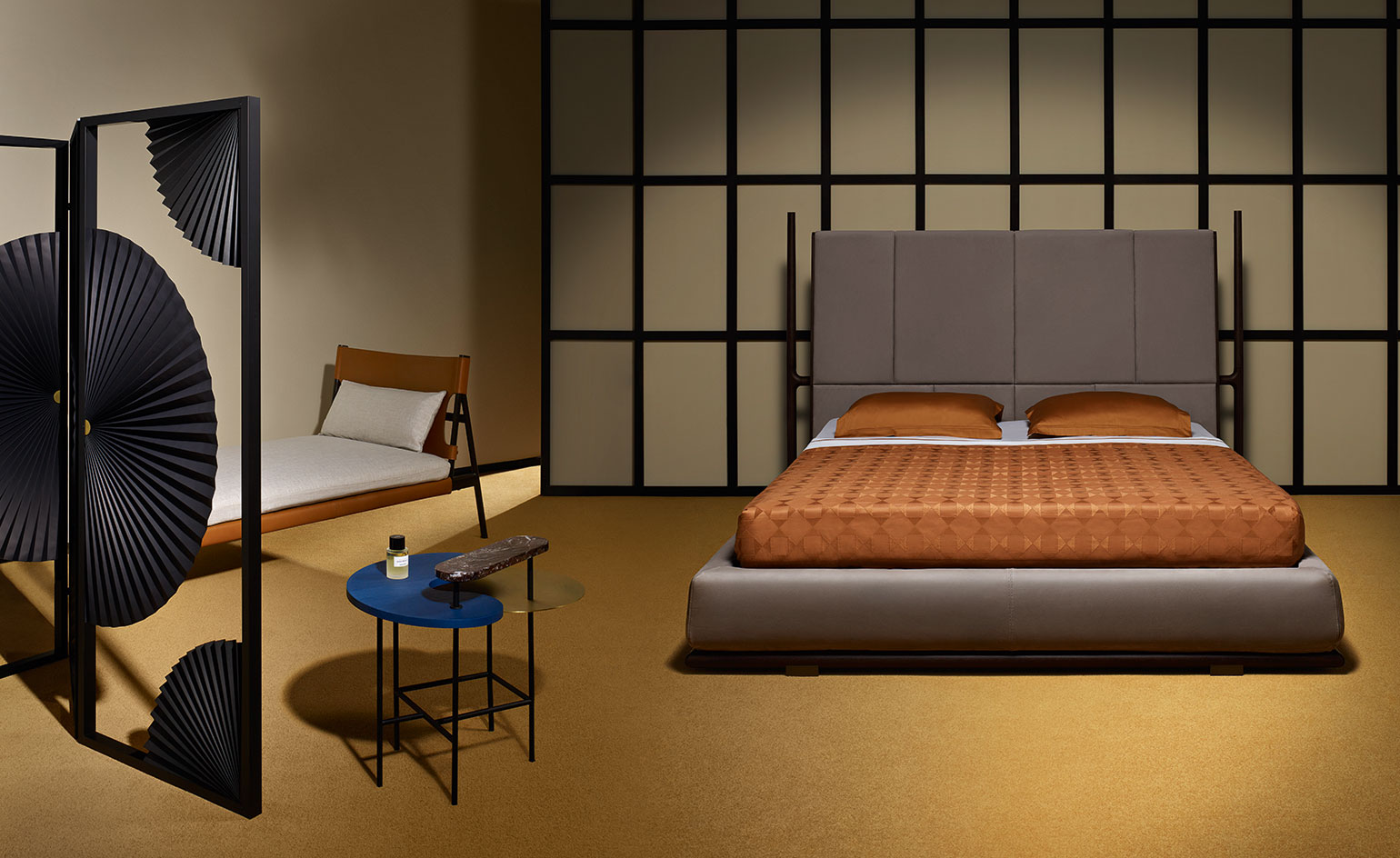
Best Bedroom
This chic platform bed and delicate fan screen are full of Eastern promise
Flexform Mood and Roberto Lazzeroni are the dream team behind the ‘Icaro’ bed, which boasts an oriental-inspired design almost guaranteed to induce a state of Zen-like calm. The bed, with its H-frame headboard (which can be upholstered in fabric or leather), forms the perfect complement to Jaime Hayon’s triple-decker side table for &Tradition and Porro’s ‘Traveller’ daybed. Taiwanese studio Kimu Lab’s ‘New Old Divider’, meanwhile, nods overtly to the East, with fold-away fans positioned on a powder-coated aluminium frame. Sweet dreams are made of these.
From left, ‘New Old Divider’ screen, $3,000, by KIMU Lab. ‘Traveller‘ daybed, £6,137, by GamFratesi, for Porro. ‘Palette JH8’ table, €1,195, by Jaime Hayon, for &Tradition. ‘Dans Mon Lit’ rose-scented linen spray, £70 for 100ml, by Bruno Jovanovic, for Éditions de Parfums Frédéric Malle. ‘Icaro’ bed, from €10,444, by Roberto Lazzeroni, for Flexform Mood. ‘Tokaïdo’ bedspread, £339; ‘Tokaïdo’ pillow covers, £75; ‘Athena’ bed sheets in Caramel, £189, all by Yves Delorme. ‘Drop Cloth’ Estate Emulsion, £39.50 for 2.5 litres, by Farrow & Ball. ‘Devonia Plain’ carpet in Sunkissed, £41 per sq m, by Axminster Carpets
Photography: John Short; Writer: Christopher Stocks
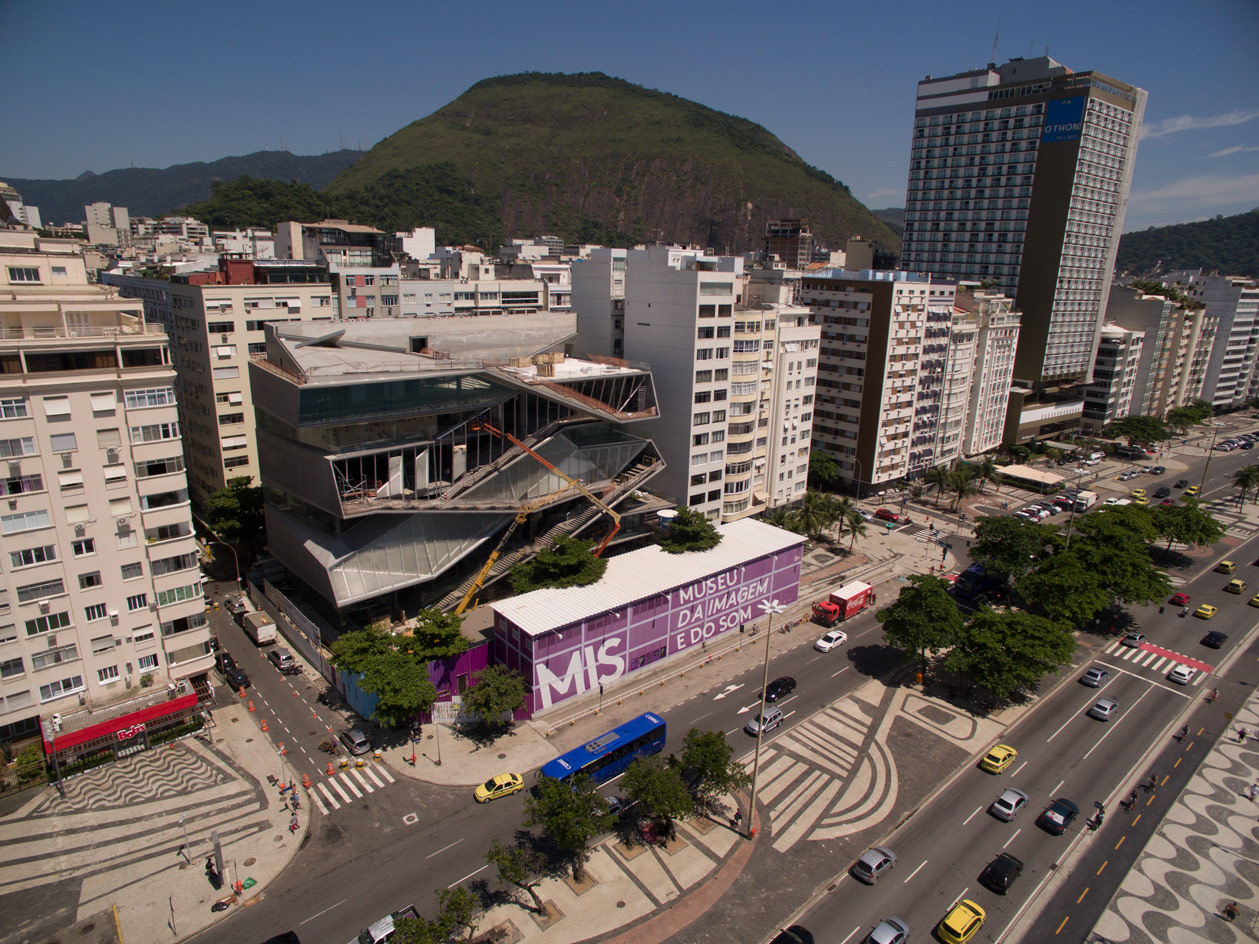
Best Building Site
Museum of Image and Sound, Rio de Janeiro, by Diller Scofidio + Renfro
Designed by New York firm Diller Scofidio + Renfro (DS+R), the 9,800 sq m, eight-storey building (two underground), in concrete, steel and glass, is partly funded by the government and the Roberto Marinho Foundation, and it takes its cue from Brazilian artist and landscape architect Roberto Burle Marx’s famous undulating wave mosaics, designed in 1971, that run along the boardwalk of Avenída Atlântica at Copacabana Beach.
‘The building is conceived as an extension of the Avenída,’ says Elizabeth Diller of DS+R. ‘The beach is Rio’s great democratic site. It unifies the city. It’s a place of socialising around natural resources, a place of spectacle. We have taken the mosaic pavement and stretched the boulevard up through the building.’ The building’s front façade features a zigzagging set of stairs, which, as visitors ascend, plays with the view, teasing with glimpses of the city. Read more here.
Pictured: The museum’s colours (grey, white and black) echo roberto Burle Marx’s wave mosaics on the Copacabana beach promenade
Photography: Peixe Voador Produções; Writer: David Baker
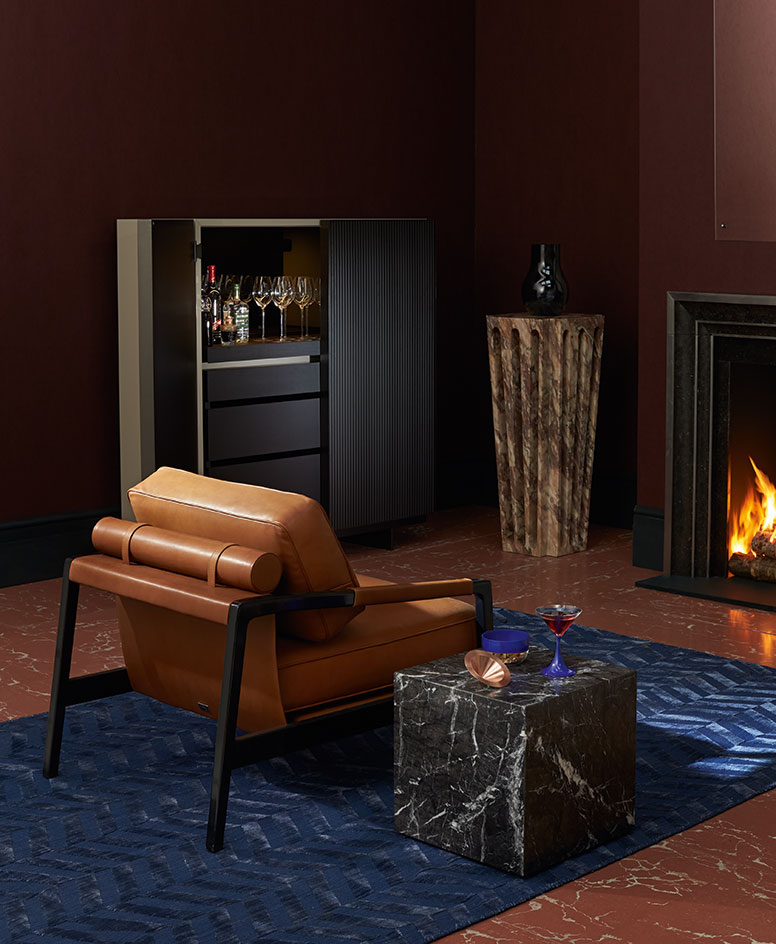
Best Cocktail Lounge
Mix and match marble, leather and lacquer for the ultimate gentleman’s den
Transform tipple time with Rodolfo Dordoni’s ‘Aylon’ cocktail cabinet, featuring elegantly reeded lacquer doors and a luxuriously crafted interior. Then recline on Fendi Casa’s ‘Kathy’ chair, upholstered in cognac leather, with a rolled-leather back support that makes it that rare thing: an armchair that, much like Pierre Gonalons’ perforated plinth and Patric Draenert’s ‘QBIC’ marble coffee table, looks as good from behind as it does from the front. We’ll raise a glass – specifically, a Turf Club cocktail from the Zetter Townhouse Marylebone – to that.
Pictured: ‘Aylon’ Drinks Cabinet, £14,235, by Rodolfo Dordoni, for Minotti. ‘Kathy' armchair, €4,440, by Fendi Casa. ‘PALAIS’ Pedestal, £20,000, by Pierre Gonalons, for Galerie Armel Soyer. ‘QBIC’ coffee table, €1,230, by Patric Draenert, for Draenert
Photography: Matthew Donaldson; Writer: Christopher Stocks
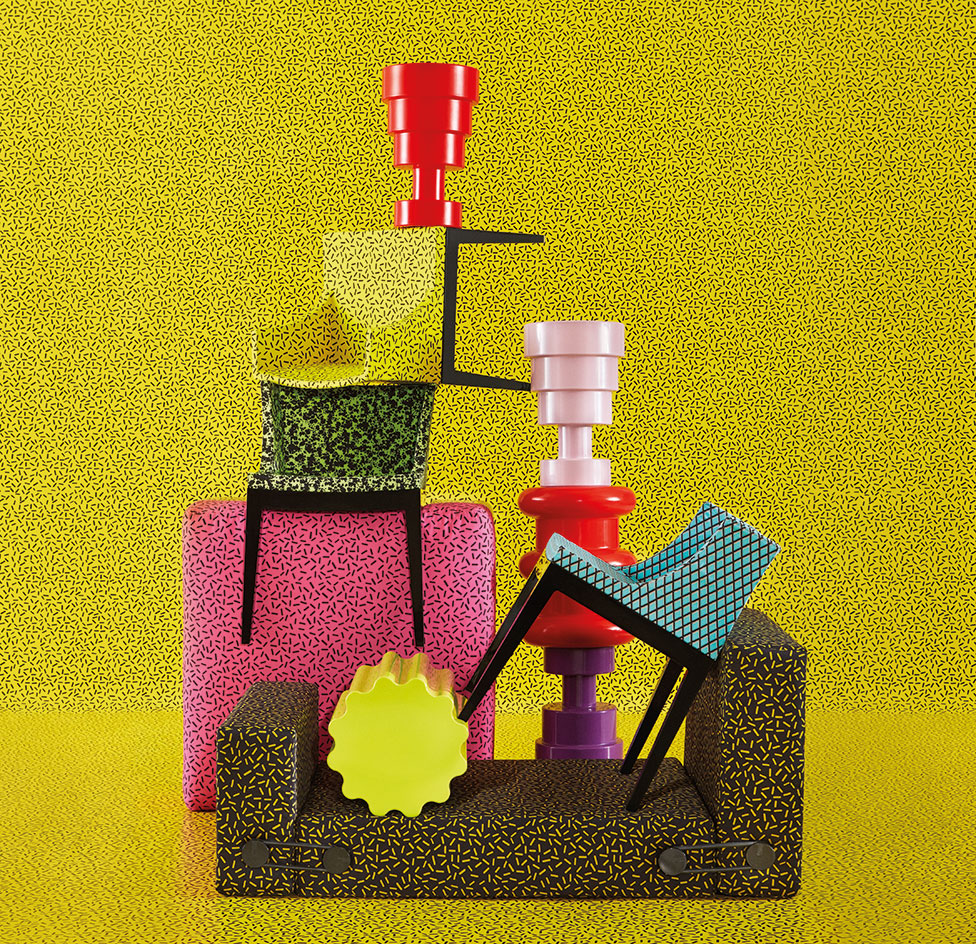
Best Collection
Kartell Goes Sottsass: A Tribute to Memphis, by Kartell
Kartell’s homage to the late Ettore Sottsass – and the Italian designer’s signature colourful geometric forms – is a collection of previously unreleased vases and stools designed in 2006. The range also includes a series of chairs in distinctive fabrics by Sottsass and fellow Memphis designers. All will be on show at Kartell’s debut London flagship store when it opens at the end of January. Kartell, 232 Brompton Road, SW3
Pictured from top: ‘Calice’ vases, £178 each, by Ettore Sottsass; ‘Mademoiselle’ chairs, by Philippe Starck, in Sottsass’ ‘Letraset yellow’, ‘schizzo green’, and ‘Rete blue’ fabrics, £547 each; ‘plastic duo’ ottoman, by piero lissoni, in Sottsass’ ‘letraset fuchsia’, from £588; ‘Trix’ sofa bed, by Piero Lissoni, in Sottsass’ ‘Letraset black’, £817; ‘Colonna’ stool, £210, by ettore Sottsass, all from Kartell
Photography: Leonardo Scotti; Writer: Rosa Bertoli
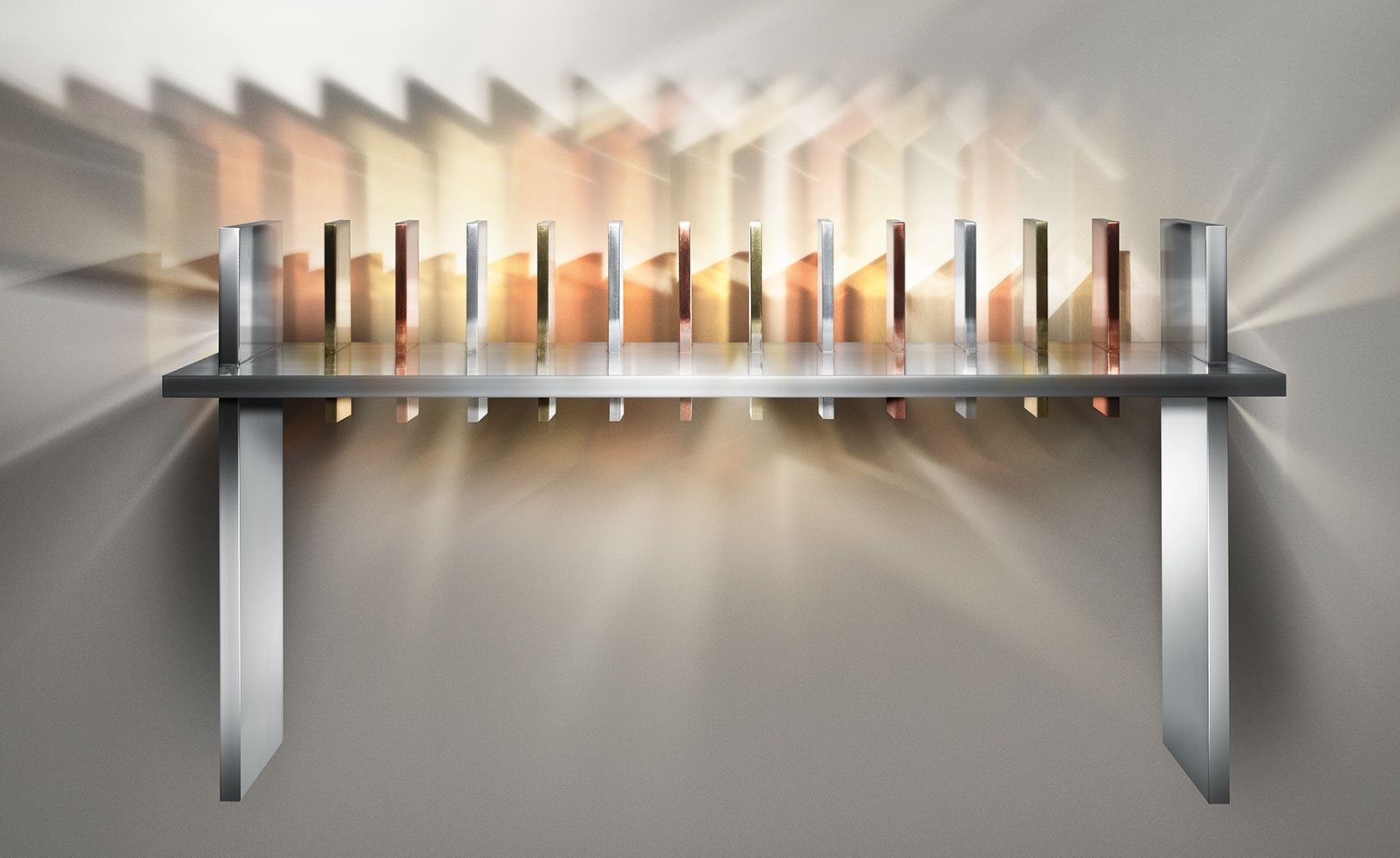
Best Big Chill
'Freeze’ desk, by Paul Cocksedge, from Friedman Benda
British designer Paul Cocksedge went to extreme lengths, and temperatures, to perfect the fabrication of his latest designs. ‘I was seeking a new way to create metal tabletops set on columnar bases without a single visible joint exposed, so I buried copper table bases and legs in the snowy Swiss Alps and there, while they froze, their circumference shrank two thousandths of millimetre,’ explains Cocksedge. Later, when the legs were slotted into place in an aluminum tabletop and ‘unfrozen’, the pieces locked together without a touch of glue or welding. Other items, like this beautifully reflective desk, were frozen in liquid nitrogen at a ship foundry in Liverpool. ‘Freeze’ desk, prototype, $90,000
Pictured: In a new take on joinery, the desk’s aluminium legs and brass, copper and steel panels were frozen to contract fractionally before being slotted into the tabletop and expanding to hold firm
Photography: Anthony Cotsifas; Writer: Brook Mason
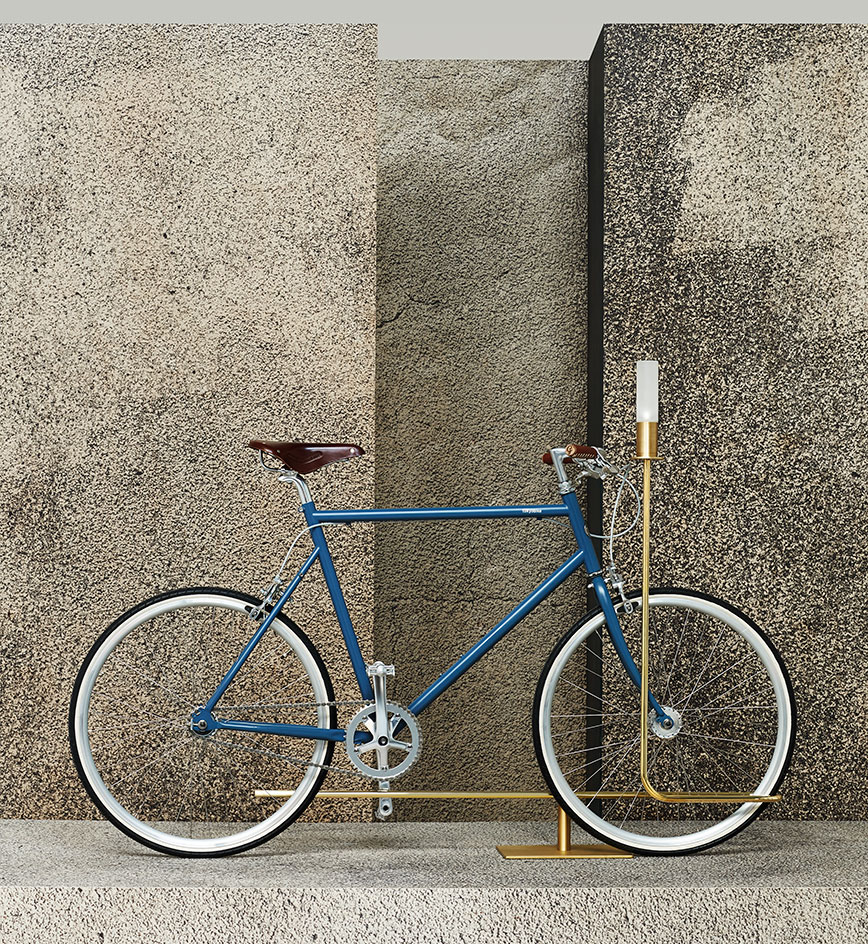
Best Bike Stand
Bi-Track’ bike stand, by Masanori Mori, for Mingardo
Young Italian craftsman Daniele Mingardo is one of our discoveries of the year. Having started his career by helping out at his father’s metal workshop after school, Mingardo soon took over the eponymous business, adding new design flair. This brass bike stand, by designer Masanori Mori, is a fitting example of Mingardo’s sophisticated production. From a simple but sturdy base, a single metal support curls up to accommodate the bike, and is topped by a discreet light: form and function go up a gear. €1,400
Pictured: 'Ace edition’ single-speed bike, £680 by Tokyobike. 'Concrete Graffiti Warm' Birch Ply Print, from £175, by Surfaceview
Photography: Matthew Donaldson; Writer: Rosa Bertoli
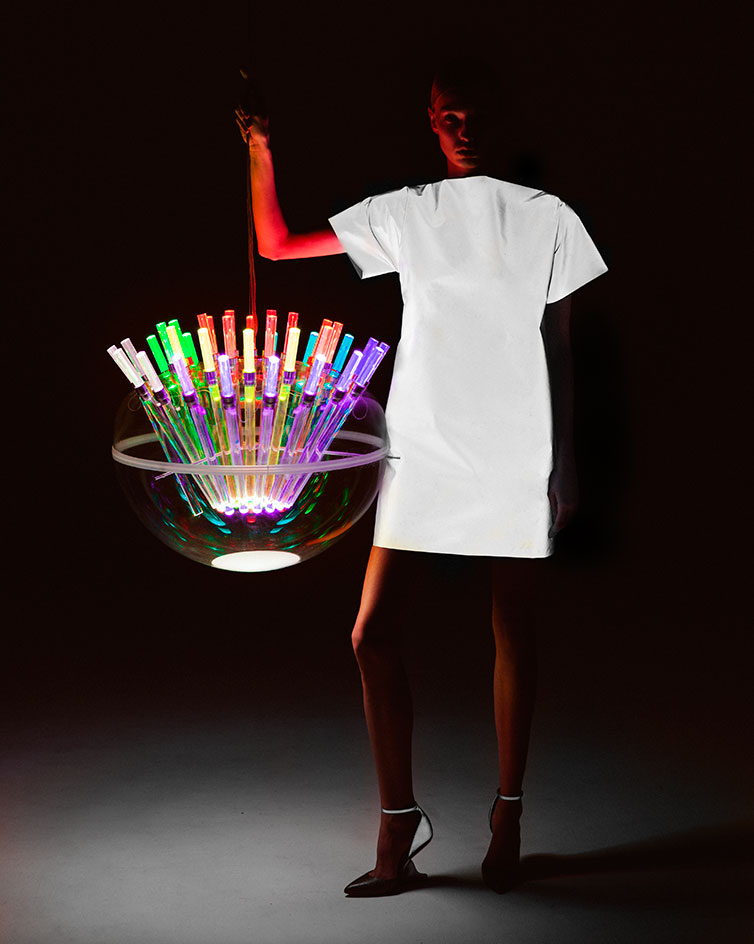
Best Bright Ideas
‘Spectral Light’, by Philippe Rahm, for Artemide
Philippe Rahm’s illuminating chandelier is the result of a huge amount of thought and research, not to mention an appealing touch of levity. It consists of 36 light tubes, which come together at the base to give a satisfyingly full-spectrum white. Each tube emits a different wavelength – 11 designed for plants, nine for humans, eight for birds, five for dogs and three for (we kid you not) hamsters. We think it reflects well on Richard Nicoll’s futuristic dress, specially designed for us. Ideas don’t get much brighter than these.
Pictured: ‘Spectral Light’, price on request, by Philippe Rahm, for Artemide custom-made dress, price on request, by Richard Nicoll. Shoes, £695, by Jimmy Choo
Photography: Ash Kingston; Writer: Christopher Stocks
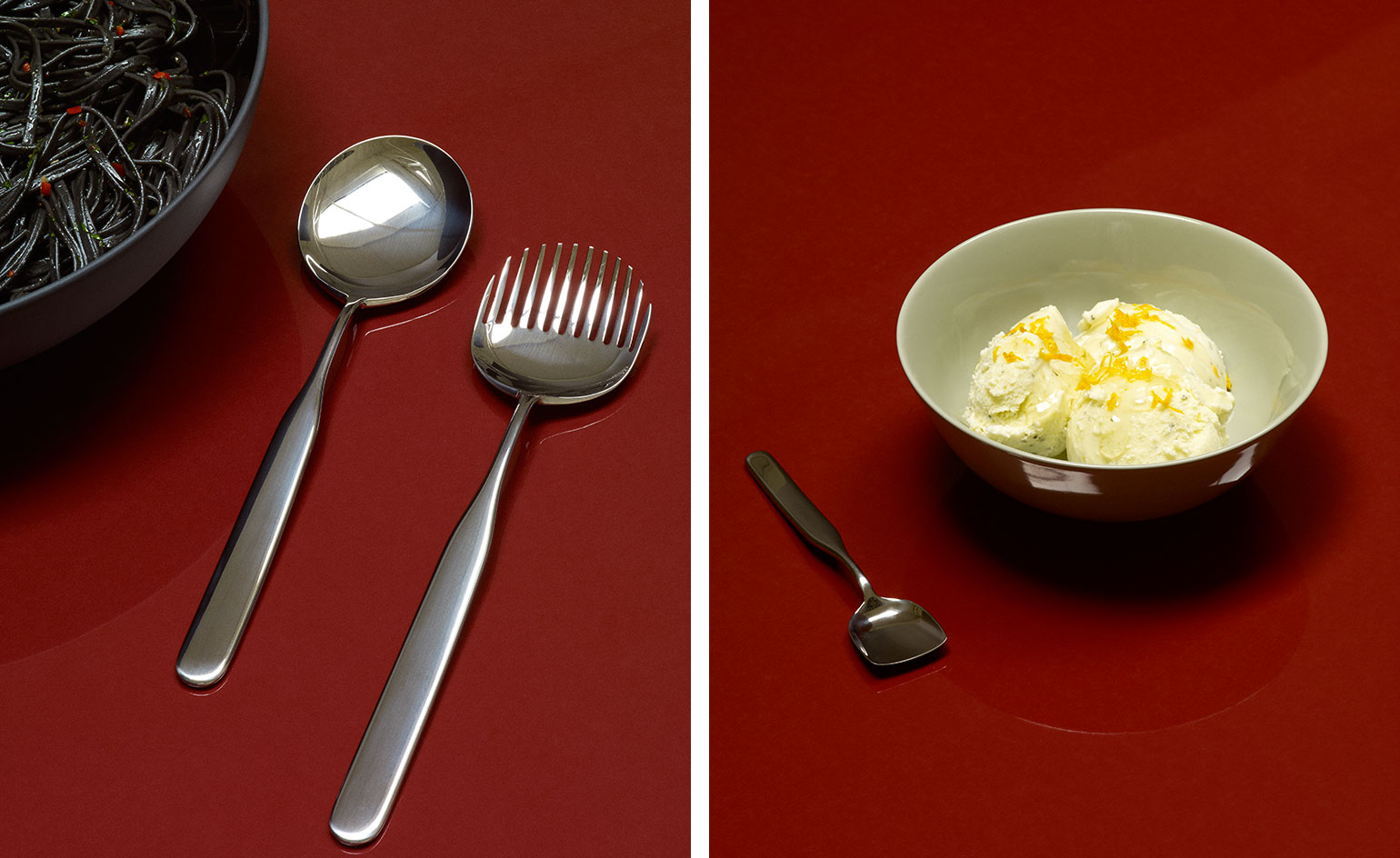
Best Cutlery
‘Collo-alto’ cutlery set, by Inga Sempé, for Alessi
Named after its distinctive long and narrow necks, Inga Sempé’s elegant new line in mirror-polished stainless steel features contrasting curved and straight lines, gently tapered stems, and rounded rather than oval spoon bowls. The set is based on the French designer’s 2012 ‘ISO1’ risotto serving spoon, created for the 5oth anniversary of the classic Italian cookbook The Silver Spoon. Its ice cream spoon, shaped like a little snow shovel, is particularly charming, as is the delightful depth of the dozen prongs on the salad servers. Available from WallpaperSTORE*
Pictured left: Soup ‘Collo-alto’ tablespoon, £9.50, by Inga Sempé, for Alessi, from WallpaperSTORE*. Pasta ‘Collo-alto’ salad set, £35, by Inga Sempé, for Alessi, from WallpaperSTORE*. Right: Ice cream: ‘Collo-alto’ gelato spoon, £7.50, by Inga Sempé, for Alessi, from WallpaperSTORE*. ‘Olio’ cereal bowl, £10, by Barber & Osgerby, for Royal Doulton. Gloss Laminate in 836 LUC-2, throughout, £6.25 per sq m, by Abet Laminati
Photography: Tobias Alexander Harvey; Writer: Nick Vinson
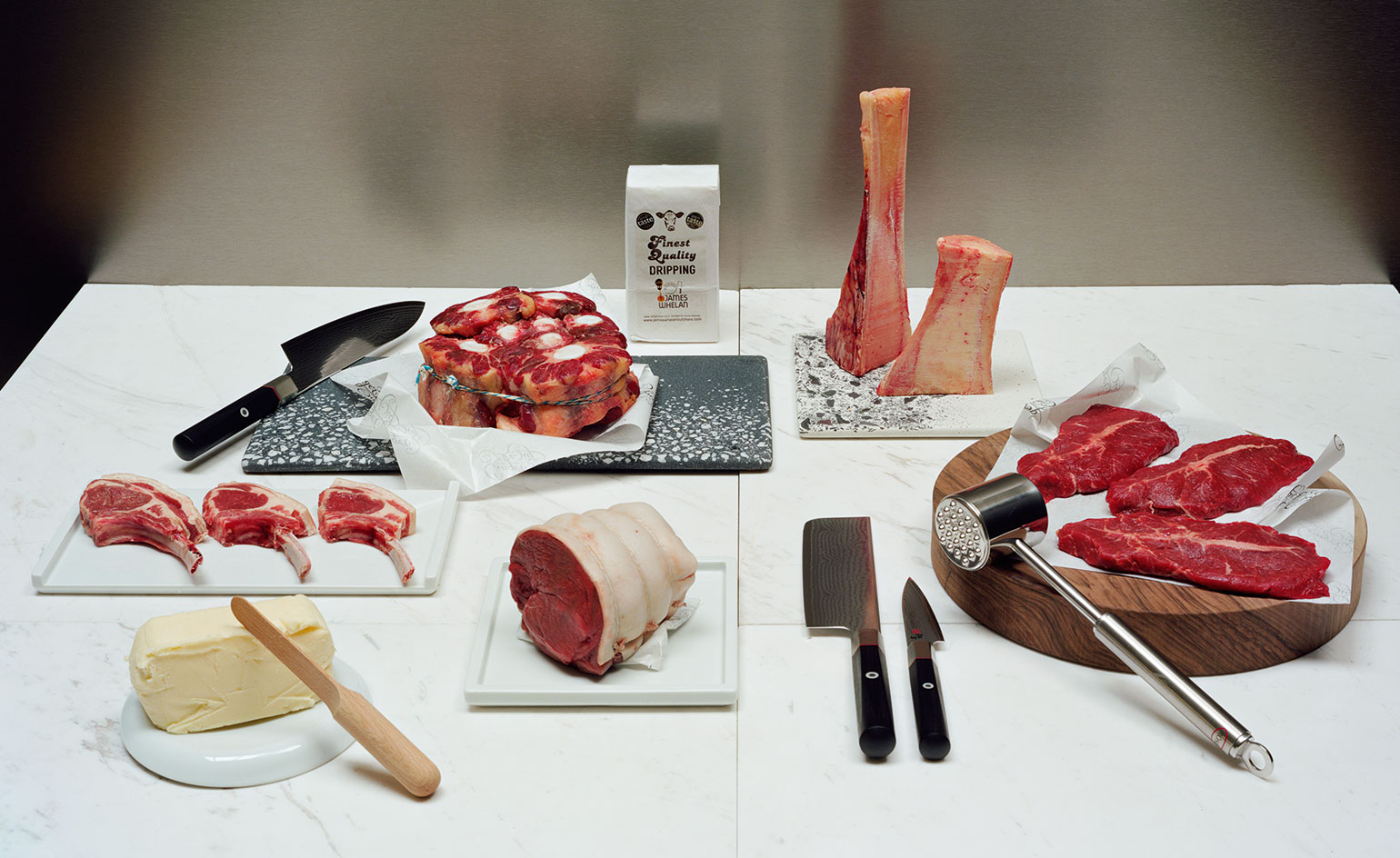
Best Cuts
Carnivores are ditching traditional barbecue staples in favour of more offbeat meat
The pejorative ‘old cow’ has, of late, become something of a gastronomic compliment. While most British beef comes from cows that are no more than two-and-a-half years old, discriminating carnivores are now hankering for a more mature lineage (17 years is not unheard of) for a deeper flavour and richer texture. Dripping and fattier cuts of meat are also staging a return, and butchers are embracing this carniverous experimentation, offering up more adventurous cuts for the weekend barbecue. Find out more about each succulent cut here.
Photography: Tobias Alexander Harvey; Writer: Daven Wu
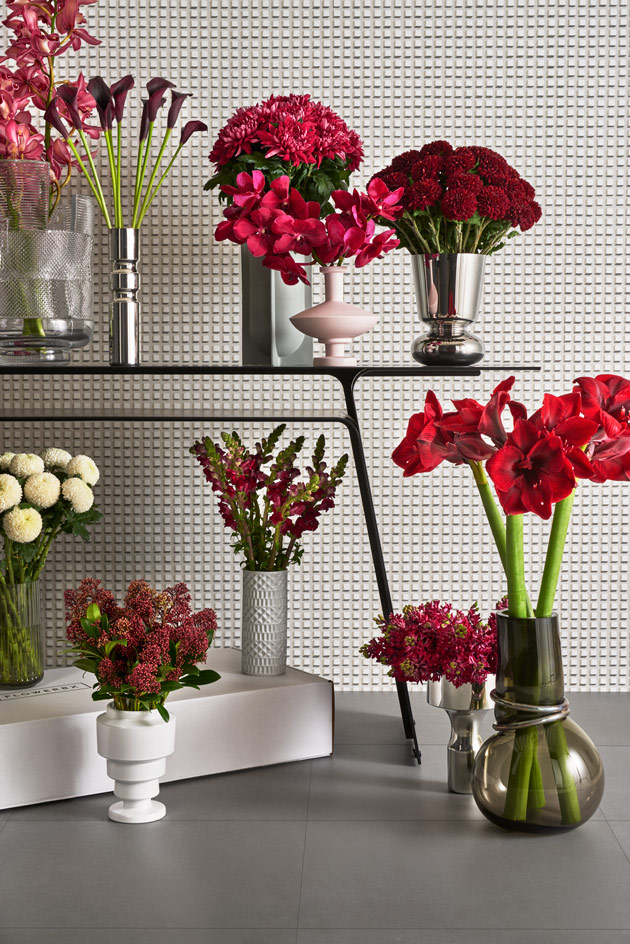
Best Delivery
Flowerbx.com
Enjoy the freshest possible buds and blooms, delivered by dashing drivers directly from the flower markets of Holland to your home or office. In place of tiresome mixed arrangements, Flowerbx delivers single-varietal bunches, such as these mulberry hyacinths, amaryllis, jazzberry jam chrysanthemums, black calla lilies, magenta snapdragons, burgundy cymbidiums and vanda orchids. Its bespoke subscription service allows you to select seasonal varieties and the frequency of the delivery you prefer, such as weekly, bimonthly or monthly. It’s only available in London for now, but we anticipate more key international locations shortly. From £24 to £66
Choose the perfect supporting act for your blooms from our superlative online edit. Clockwise from top left, ‘Patchwork’, from £641, by Nendo, for Lasvit; ‘Double Groove’, from £70, by Miranda Watkins; ‘Domo’,£160, by Sebastian Herkner,for Rosenthal; ‘V4’, £446, by Linck Keramik; ‘Alfredo’, £120, by Alfredo Häberli, for Georg Jensen; ‘Double Ring’, £165, by Vanessa Mitrani; ‘Flare’, £137, by Miranda Watkins; ‘Portomarínico’, £28, by Sargadelos; ‘V40’, £403, by Linck Keramik; ‘Smoke’, £60, by Lyngby, all from WallpaperSTORE*, ‘Inari’ console table £1,612, by Mist-o, for Living Divani. ‘Geometric II Mosaic’ wallpaper, £76 per 10m roll, by Cole & Son. ‘Mosa Solids’ tiles in Stone Grey, price on request, by Mosa
Photography: Gustav Almestål; Writer: Nick Vinson
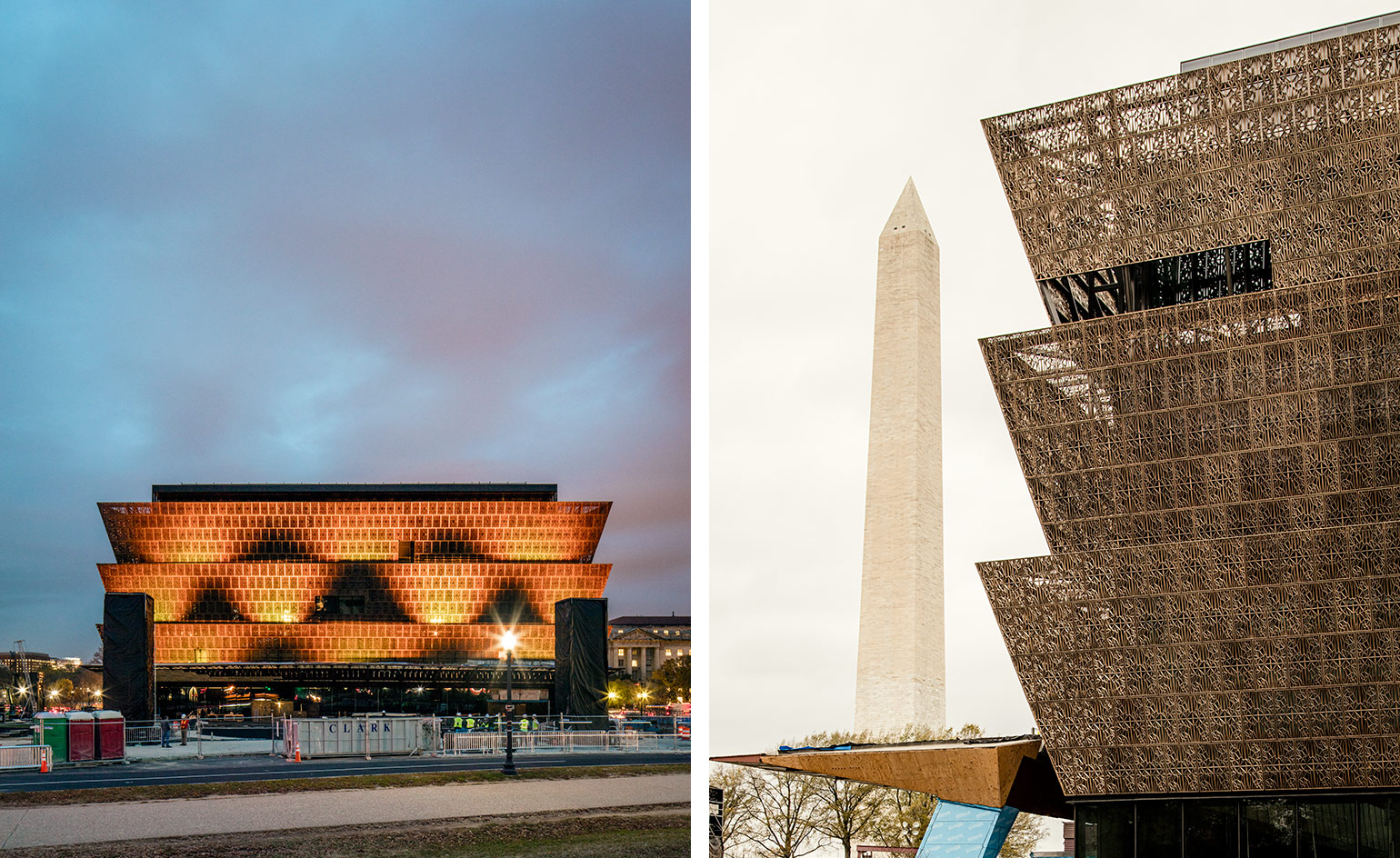
Best Cultural Draw
National Museum of African-American History and Culture, Washington, DC
With its exterior walls now in place and glinting above the National Mall – the green swath at the heart of Washington, DC – the National Museum of African-American History and Culture (NMAAHC) is most of the way through its four-year build. But the vision it fulfils is much older than that.
In 1915, black veterans of the US Civil War proposed building a national memorial to African-American achievement. The idea languished for decades, and attempts to revive it in the 1970s and 1980s met with political opposition. Finally, in 2003, the US Congress authorised a museum dedicated to the African-American experience, and assigned it the last buildable site on the Mall, close to the Washington Monument. Find out more about David Adjaye's ambitious plans for the museum here.
Pictured left: the museum’s tiers have been angled at 17 degrees, to match the pinnacle of the washington monument, while a canopy over the entrance nods to vernacular African-American architecture. Right: the decorative cladding comprises 3,600 panels and is made of aluminium with a bronze-coloured finish
Photography: Stefan Ruiz; Writer: Amanda Hurley
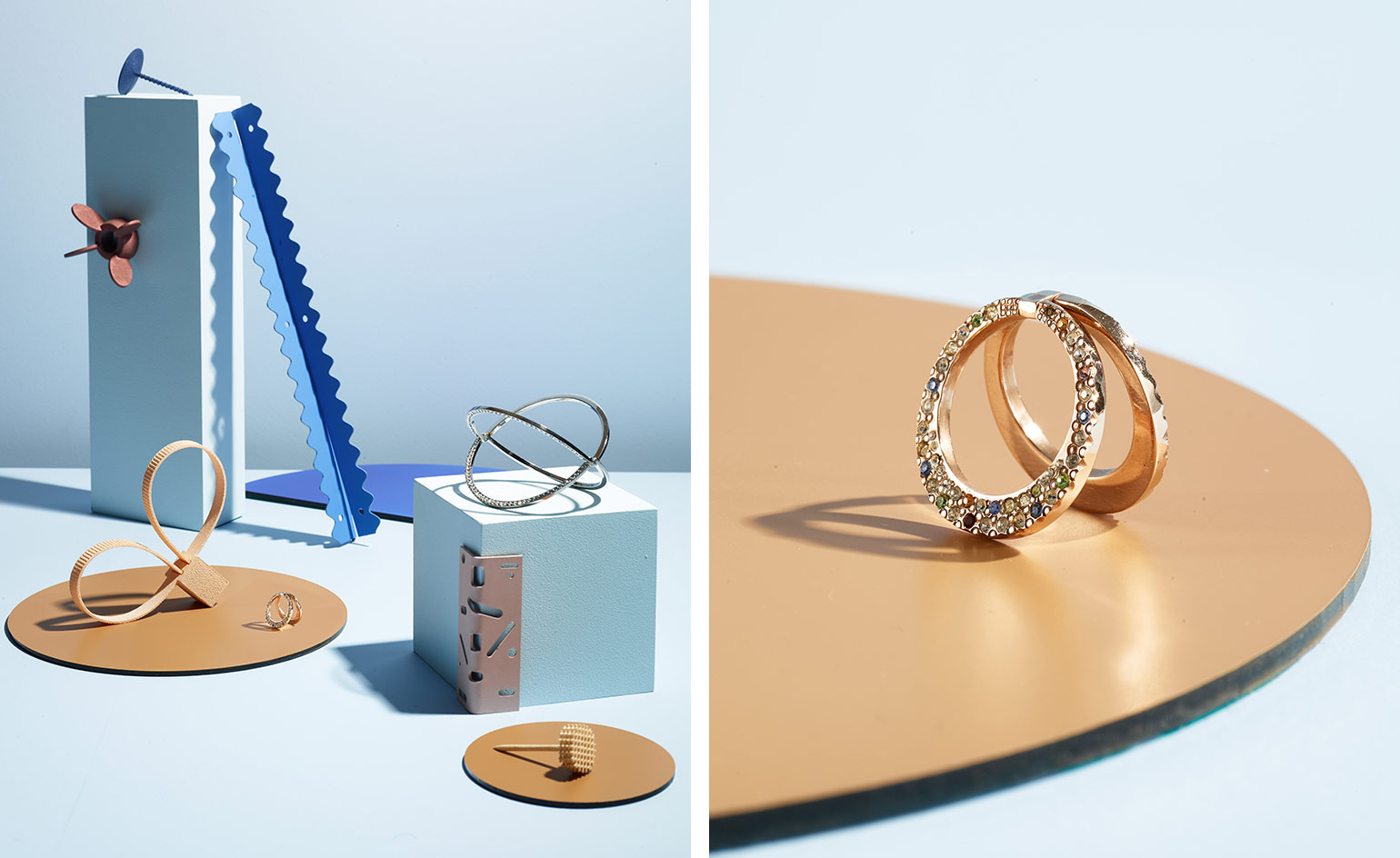
Best Details
Construct Me! hardware, by Droog
God is in the detail, as Mies van der Rohe may or may not have said. And so it is to Droog. The Dutch company has produced Construct Me!, a set for those who worry that their hardware isn’t happy enough. Amid the smiling screws, chirpy hinges and cheerfully patterned brackets is some genuine functional innovation: the 210 item-strong collection includes nail heads that make hitting your finger impossible, double-sided cable ties and multi-handled wing nuts.
Jewellery, by Kim Mee Hye
It’s not only the rare nature of the materials that make jewels feel good to wear but the extent of the skill that shapesthem. Clever, careful articulation denotes a considered understanding of the fact that, above all, jewellery is designed to fit the body; to be worn. In Kim Mee Hye’s hands, mechanisms become the precious element, as bracelets and rings conceal exceptionally crafted hinges that allow her designs to double up or softly fold out into a new form.
Pictured left: from top, flat cross screw; hinge; wing nut; double tie wrap; pattern bracket; flatmesh nail, all prototypes, from the construct me! hardware collection, by Droog Swing. Swing’ ring in white and coloured diamonds, €9,225; ‘Twisted’ Bracelet in white gold and white diamonds, €3,700, both by Kim Mee Hye, from Browns. Right: enlargement of the Swing’ ring in white and coloured diamonds, €9,225
Photography: Paul Zak. Writers; Paul McCann, Caragh McKay
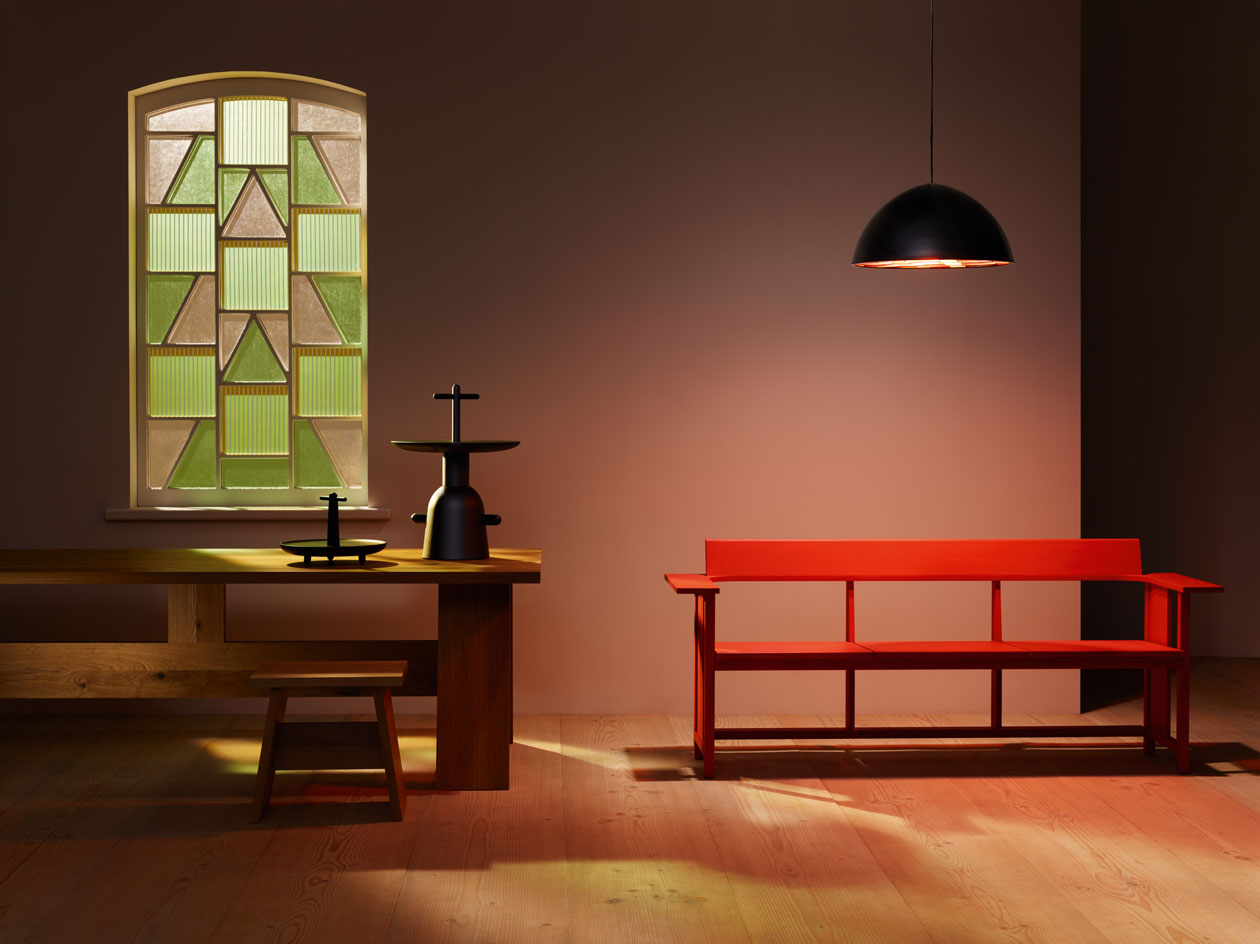
Best Divine Inspiration
We’re worshipping at the high altar of great design
There is something pleasingly ascetic about our take on ecclesiastical design. Konstantin Grcic’s serene wooden bench, David Chipperfield’s austere stool and table, and Jaime Hayon’s modern-day Le Corbusier-inspired totems all bask in the heavenly illumination of Lee Broom’s stained glass pendant. And we’re hopelessly devoted to Dutch designer Marjan van Aubel’s window, which doubles as a charging station, using light-absorbing coloured solar cells to convert energy from the sun into electricity. Praise be!
Pictured: ‘Fayland’ oiled oak table, £3,830; ‘langley’ oiled oak stool, £500, both by David Chipperfield, for e15, from Viaduct. ‘Current Window’, price on request, by Marjan Van Aubel. ‘081 RÉaction PoÉtique 04’ centrepiece, £390; ‘081 RÉaction PoÉtique 06’ centrepiece, £990, both by Jaime Hayon, for Cassina. ‘Clerici’ bench, from €1,210, by Konstantin Grcic, for Mattiazzi. ‘Chapel Light’, £3,960, by Lee Broom. Grand Douglas natural flooring, from £75 per sq m, by Dinesen. ‘Skimming Stone’ estate emulsion, £38 for 2.5 litres, by Farrow & Ball
Photography: Michael Bodiam; Writer: Rosa Bertoli
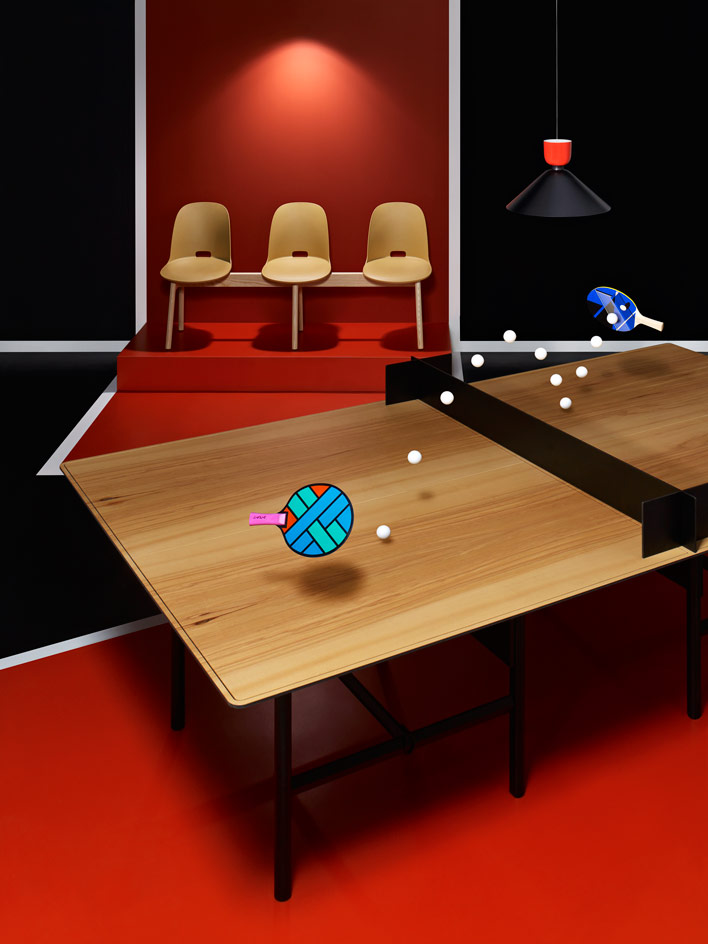
Best Game Changers
Sleek yet playful designs you’re sure to have a ball with
Thanks to this ping-pong/meeting-room table by Belgian office specialist Bulo, there’s no need to choose between work and play. Its stained veneered top comes with a removable black laminate ‘net’, complemented by dark stained ash legs inspired by traditional Japanese joinery. Pair it with a three-seat ‘Alfi’ bench by Jasper Morrison, comprising wood-filled reclaimed polypropylene seats on an ashwood base, and you’ll have no trouble bouncing ideas off each other at the next office meeting. (However, if ping pong tables are what you are after, we have a stellar line-up for you here)
Pictured: ‘Alfi’ bench, €1,134, by Jasper Morrison, for emeco. ‘Dan’ ping-pong table, by Bulo. ‘Alphabeta’ light, £238, by luca nichetto, for hem. Table tennis bats, left, £424, by Supermundane; right, £384, by Malika favre, both for the Art of Ping Pong. red Paint, £22 for 2.5 litres, by Valspar. ‘sevilla’ vinyl flooring, £70 per sq m, by Amtico
Photography: John Short; Writer: Léa Teuscher
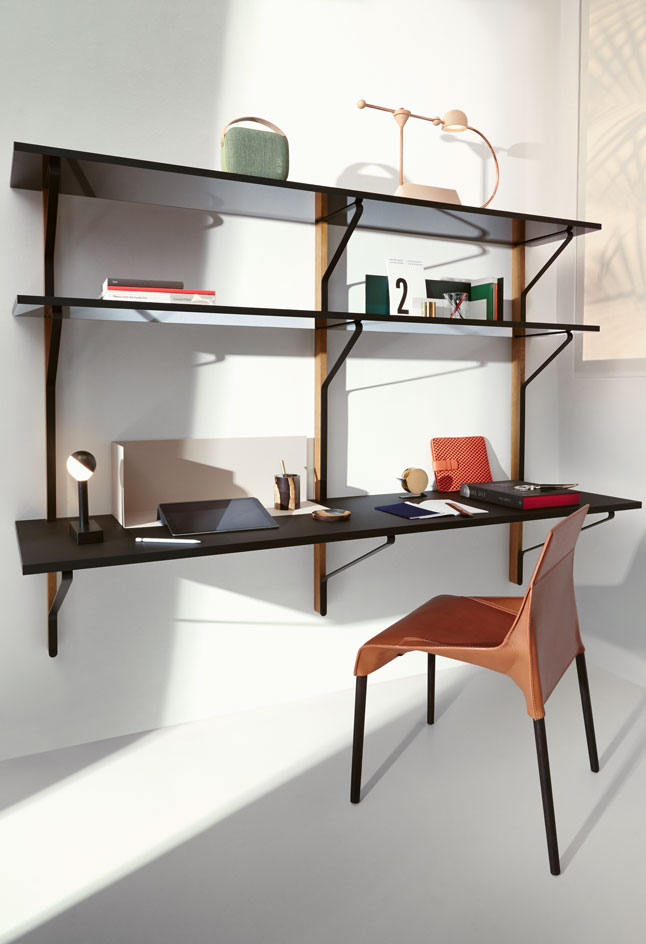
Best Home Office
We’re exploring efficient new angles with a terrific-looking taskforce
The desk gets an unexpected lift – right up off the floor – from the Bouroullec brothers, whose Kaari collection for Artek rethinks tables and shelving with signature triangular bent-steel supports. Also subtly working the angles is Jean-Marie Massaud’s svelte and sophisticated leather ‘Seattle’ chair for Poliform. And in a new slant on the desk lamp, Industrial Facility’s ‘w152 Busby’ for Wästberg powers through our charging needs courtesy of three USB ports, while casting an adjustable ambient glow.
Pictured from left: ‘Reb010 Kaari’ shelf with desk, £1,968, by Ronan & Erwan Bouroullec, for Artek. ‘Seattle’ chair, £1,987, by Jean-Marie Massaud, for Poliform, ‘w152 Busby’ lamp (bottom left), from €469, by Industrial Facility, for Wästberg. iPad Pro, from £679; Apple Pencil, £79, both by Apple
Photography: Catherine Hyland; Writer: Bridget Downing
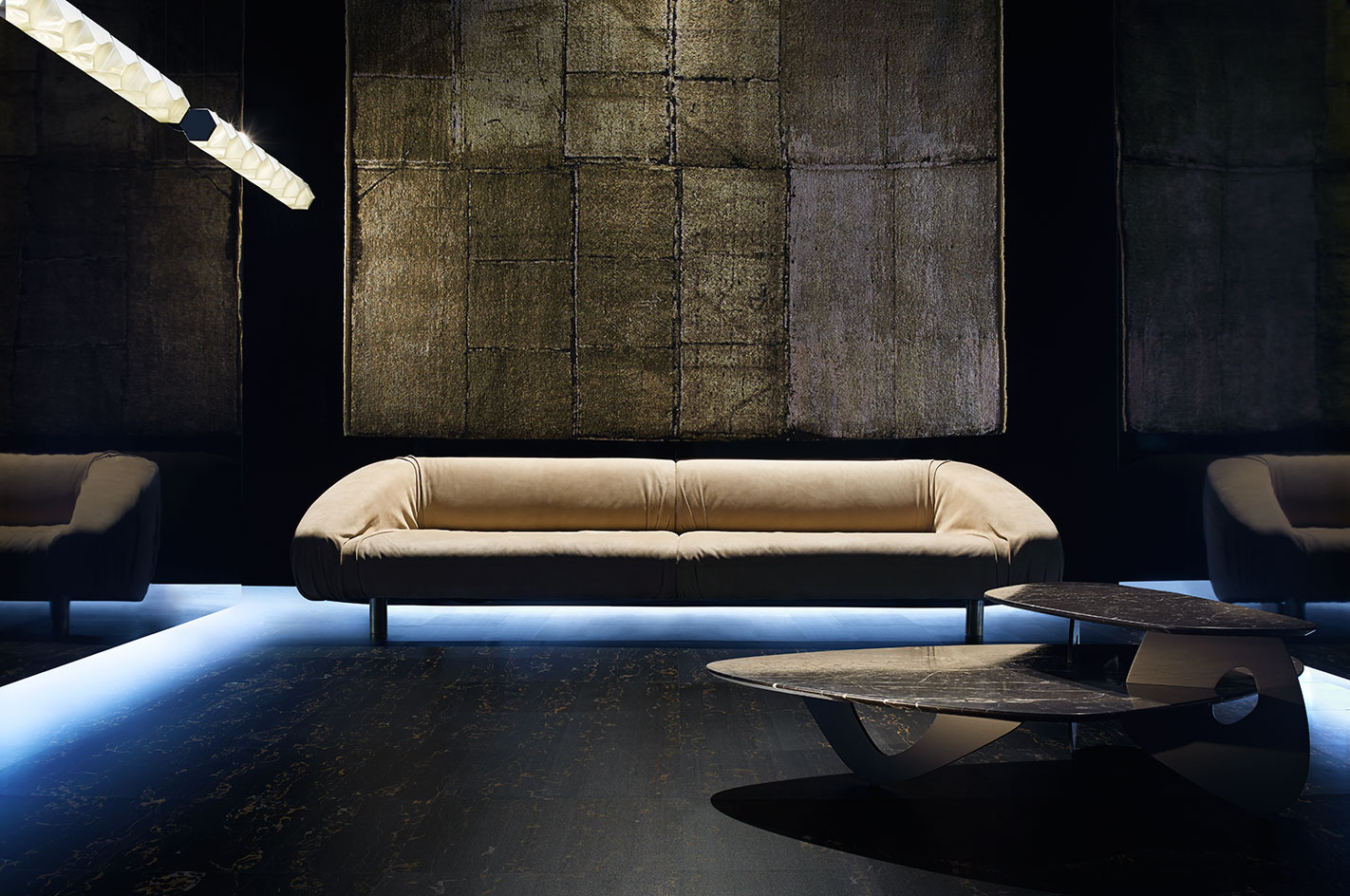
Best Lair
Plot global domination from his stylish underground base
Plotting world domination is tiring work. We suggest a little lie down on Vincenzo De Cotiis’ ‘Fold’ sofa forBaxter. The secret of this butter-soft leather sofa lies in its folds, executed with technical precision to create a seemingly effortless result. Even cold-hearted megalomaniacs like to be cosy; adding warmth to our bunker chic is Jan Kath’s ‘Billboard’ rug collection – textural works in wool, silk and nettle – based on photographs of the scratched metal panels of the blank billboards that line the highways around Bangkok. Finally, our lair wouldn’t be complete without Eoos’ ‘Tama’ table for Walter Knoll, which takes its cues from the sculptures of Alexander Calder and riffs off Isamu Noguchi’s iconic coffee table.
Pictured: 'Fold' sofa in Kashmir Miel leather, £14,690, by Vincenzo de Cotiis, for Baxter. 'Billboard 1' rug, from €1,750 perv sq m, by Jan Kath, 'Tama' table in black marble, £6,510, by EOOS, for Walter Knoll, from Aram. 'Hugo' light, £350, by Slamp
Photography: Andy Barter; Writer: Lea Teuscher
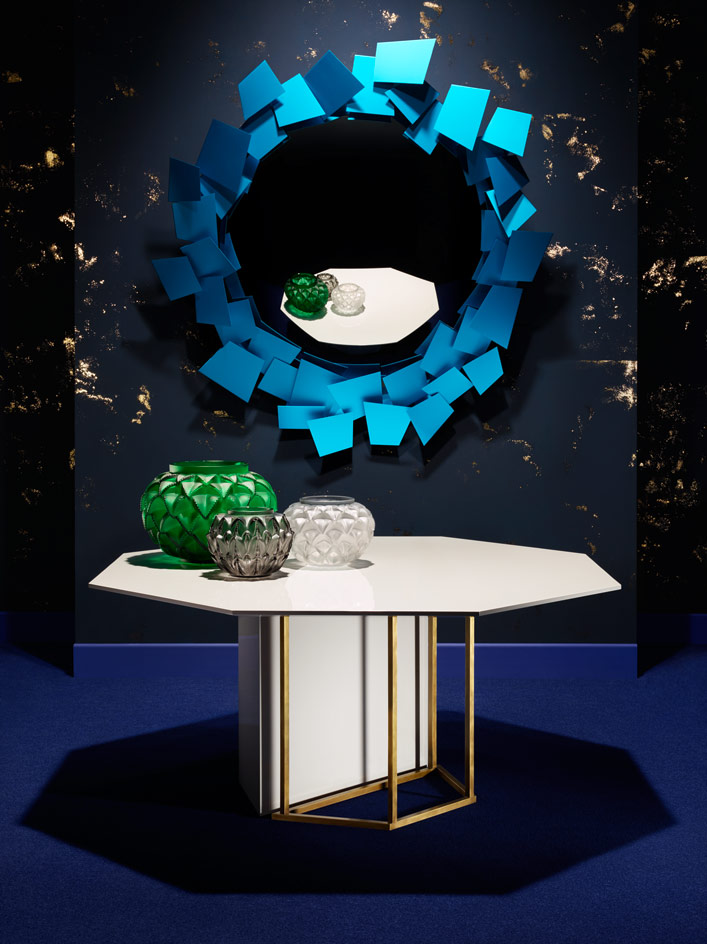
Best Maximalist Dining
Top of our entertaining glitz list
As this lavish selection of oversized and embellished pieces demonstrates, sometimes, more is simply more. We were particularly taken by Herve Van der Straeten's origami-inspired mirror, featuring myriad aluminium panels, and Rene Lalique's organic vases, adorned with cactus and artichoke leaves. More subtle but still the right side of glitzy are Meridiani's octagnoal lacquered table, with a gleaming bronzed brass base, and Custhom's hand-foiled 'Igneous' wallpaper, liberally speckled with gold.
Pictured from top: 'Akimitsu' mirror, price on request, by Herve van der Straeten. 'Languedoc' vase in grey, €3,600; 'Languedoc' vase, €4,400, all by Rene Lalique, for Lalique. 'Plinto' table, €5,232, by Andrea Parisio, for Meridiani, 'Ingeneous' wallpaper, £165 per roll, by Custhom. 'Devonia Plain' carpet in town blu, £41 per sq m, by Axminster Carpets
Photography: Michael Bodiam; Writer: Sujata Burman
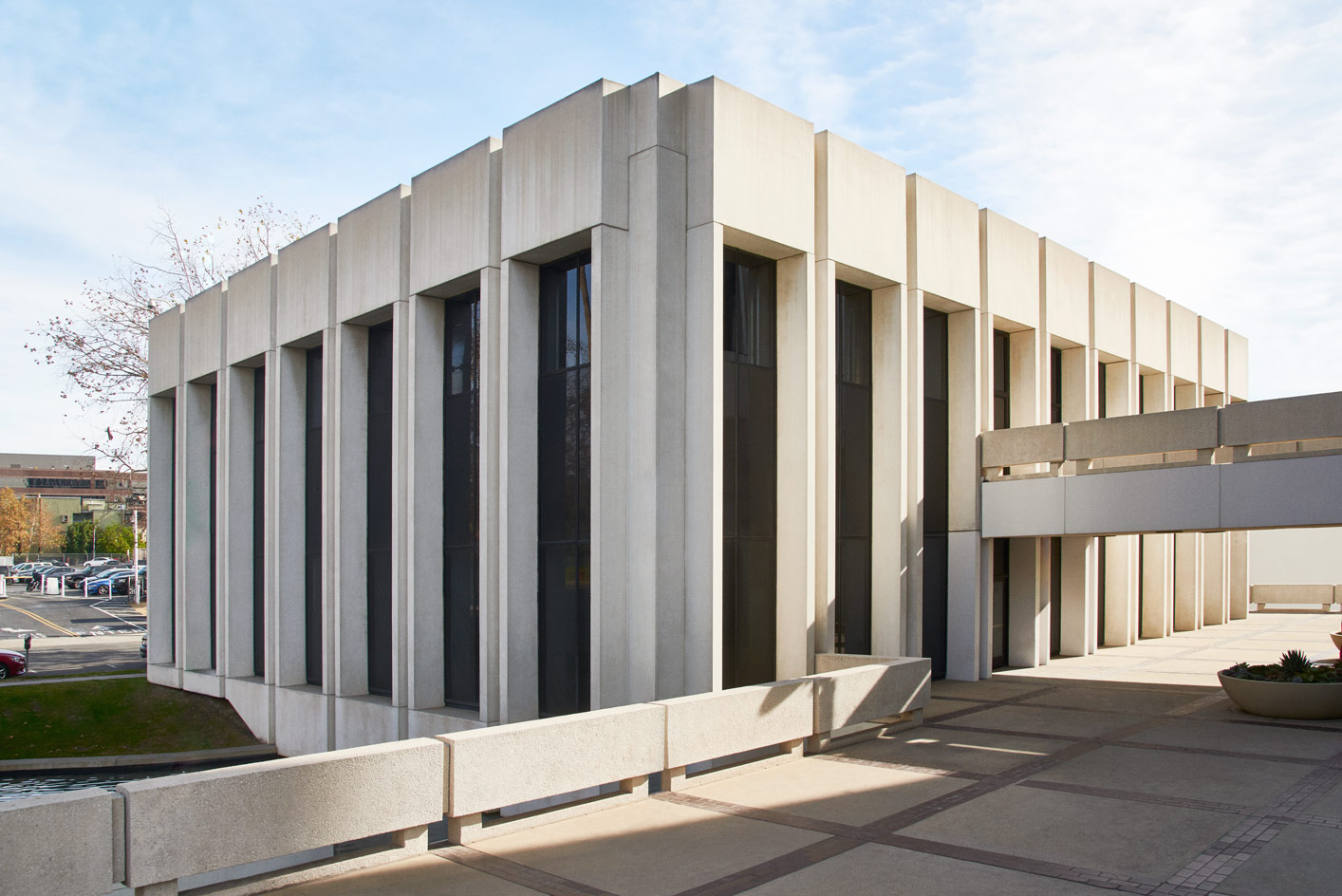
Best New Gallery
Sprüth Magers, Los Angeles
Nicknamed the Miracle Mile in the 1960s for its now long-gone glamorous department stores, Los Angeles’ Wilshire Boulevard is undergoing a cultural revival. Not only has the Los Angeles County Museum of Art (LACMA) been transformed with Renzo Piano additions and new permanent installations, but leading European gallery Sprüth Magers is now opening its first US outpost right across the street from the museum. German dealers Monika Sprüth and Philomene Magers wanted a space to showcase their LA artists, especially John Baldessari, with whom they have been working since 1988, and Sterling Ruby, shown since 2007.
Both gallerists have a passion for architecture; Sprüth practised as an architect until 1983, when she opened her first gallery in Cologne. Magers studied art history and found inspiration in the 1920s Wittgenstein House for her master’s thesis before opening her gallery in 1991, also in Cologne. Having combined forces in 1998, the pair concentrated on opening galleries in buildings with original architecture, seeing the spaces’ cultural history as an element in their exhibition programme. After a stint in Munich, they opened a gallery in London’s Mayfair, in a 19th-century townhouse, and another in Berlin, in the dance hall of a former social club. ‘In our experience, it is more interesting for artists to deal with defined architecture,’ says Sprüth. ‘We like to find a space that is very specific to that city.’ Read more about Sprüth Magers' LA opening here.
Pictured: The new gallery is housed in a two-storey 1971 building designed by Pereira & Associates as part of a complex with a high-rise, a plaza and a reflection pool. The gallery has some 7,000 sq ft of space on each level. Courtesy of Marian Goodman Gallery
Photography: Spencer Lowell; Writer: Hunter Drohojowska-Philp
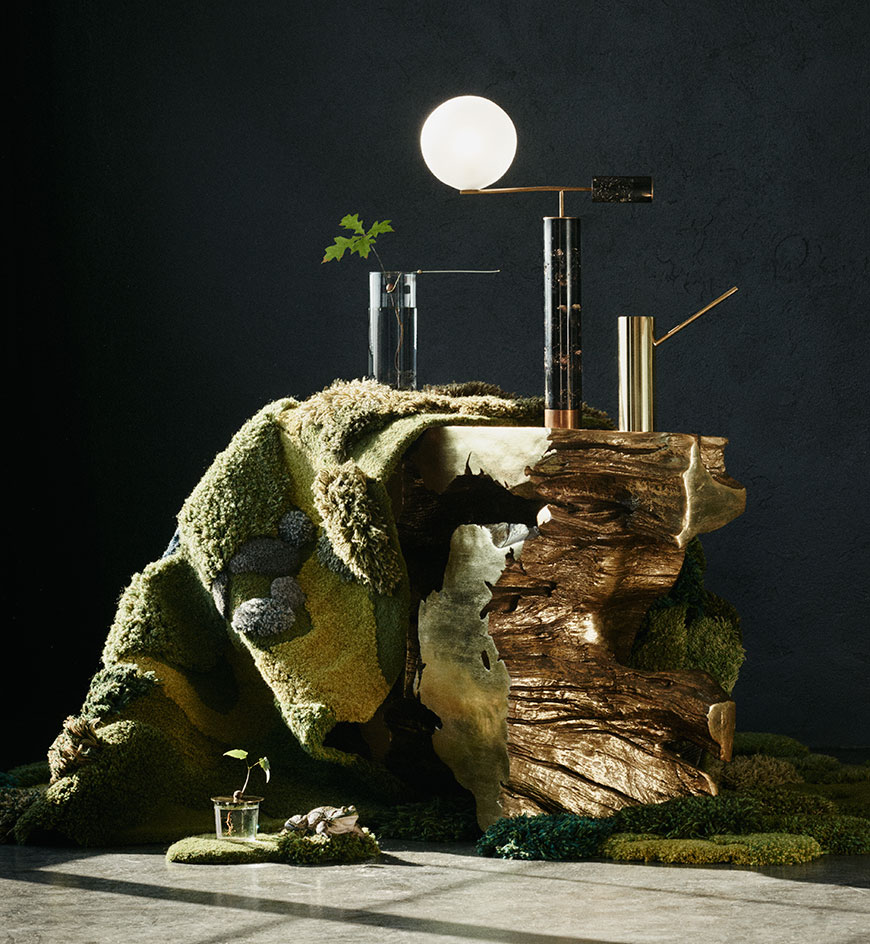
Best Natural Selection
We’ve gone in quest of the finest flora-inspired design specimens
The more we submerge ourselves in our screens, the more designers turn to the actual, natural world, from Marcin Rusak’s ‘Flora’ lamp, which incorporates dried flowers in black resin, to Michael Anastassiades’ series of deftly crafted polished brass cradles for seedling plants. At the more baroque end of the spectrum, RH Modern’s console table takes the form of a cast-metal tree stump, while Alexandra Kehayoglou’s extraordinary hand-tufted rugs are inspired by the pastures of her native Argentina. Everything’s gone green.
Pictured: from left, ‘Pastizal’ rug, $18,970, by Alexandra Kehayoglou, from Chamber. ‘Floating Forest Series’, prices on request, by Michael Anastassiades. Oak and birch seedlings, price on request, from Dig. ‘Cast Cambium’ Console Table, $1,195, by RH Modern. ‘Flora’ Lamp, price on request, by Marcin Rusak. Watering Can, £472, by Lee West, produced by Carl Auböck, from Another Country
Photography: Joss McKinley; Writer: Christopher Stocks
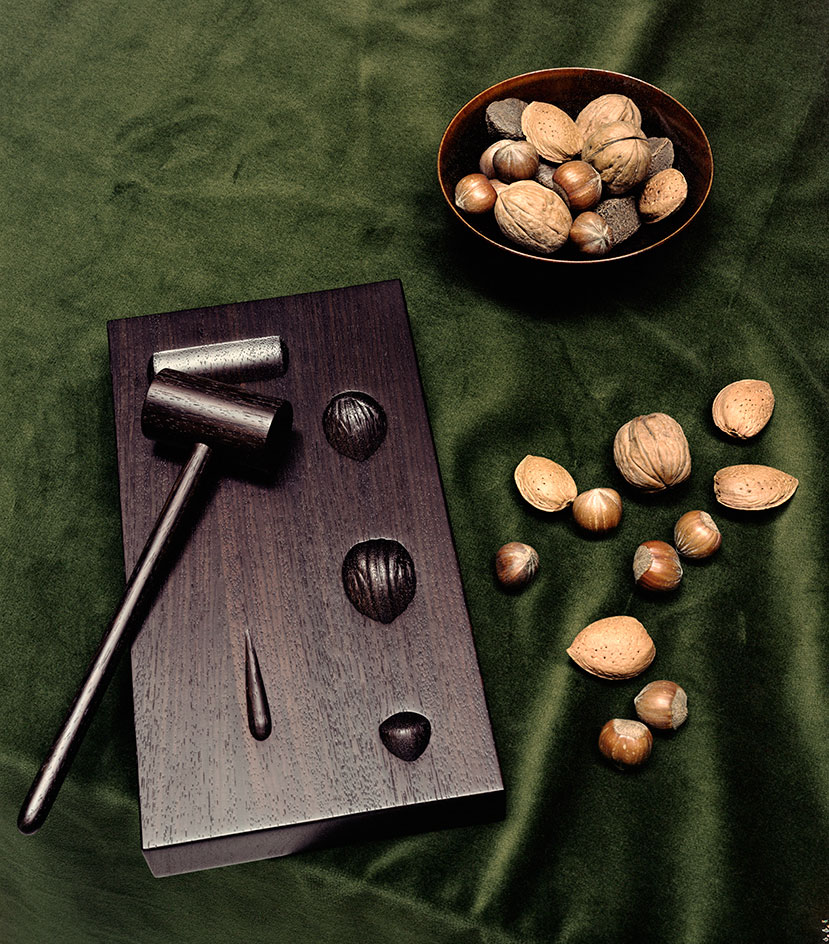
Best Nut Buster
Nutcracker, by Hermès
We’re nuts about nuts, so Hermès’ natty new nutcracker is right up our street. Made from polished rosewood and carved entirely by hand, it comprises a dinky rosewood hammer and base, featuring three nut-shaped niches: one for an almond, one for a walnut and one for a hazelnut. We think it’s well worth shelling out for.
Picutred: Rosewood nutcracker, £415, by Hermès. Stoneware bowl, £82, by Christiane Perrochon, from Willer. ‘Rubino’ fabric in Forest, €211 per panel, by Nya Nordiska
Photography: Tobias Alexander Harvey; Writer: Christopher Stocks
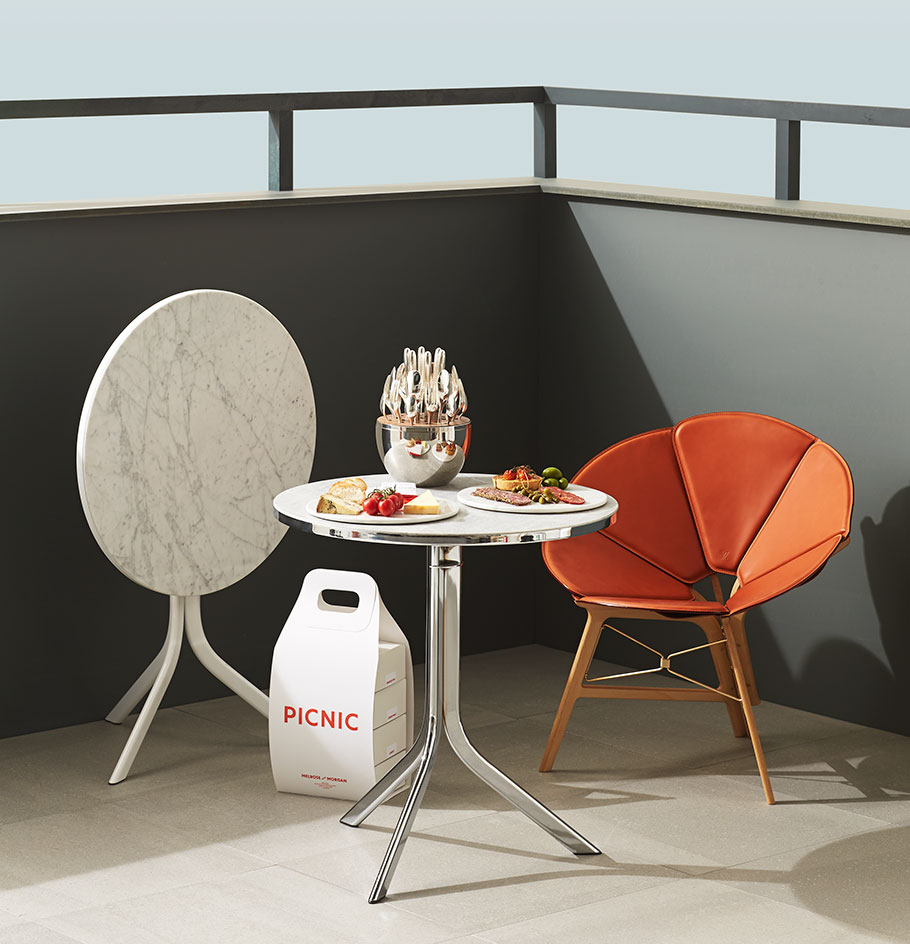
Best Posh Picnic
Bringing high style and foldaway fabulousness to the table
When it comes to al fresco feasting, we see no reason to lower our design standards. Retegui’s folding marble-topped ‘Bistro’ tables are the ideal solution. Designed by Jean Louis Iratzoki, they’re sturdy, stylish and lighter than they look, thanks to clever composite construction. Inspired by the unfurling petals of a flower, Raw-Edges’ ‘Concertina’ chair for Louis Vuitton folds up too, while Christofle’s clever 24-piece cutlery set sits snugly inside its silver-plated ‘egg’. Snacktastic.
Pictured: ‘Bistro’ Tables, from €1,300 each, by Jean Louis Iratzoki, for Retegui. ‘PicMix and Match’ picnic, £15 per tray, from Melrose and Morgan. ‘Mood’ 24-Piece cutlery set with Storage Capsule, €950, by Christofle. Marble Placemats, £95 each, from the Conran shop. ‘Concertina’Chair, price on request,by Raw-Edges, for Louis Vuitton. ‘Down Pipe’ emulsion; ‘Black Blue’ emulsion, £38 per 2.5 litres, both by Farrow & Ball. ‘Mosa Solids’ tiles in Stone Grey, price on request, by Mosa
Photography: Matthew Donaldson; Writer: Christopher Stocks
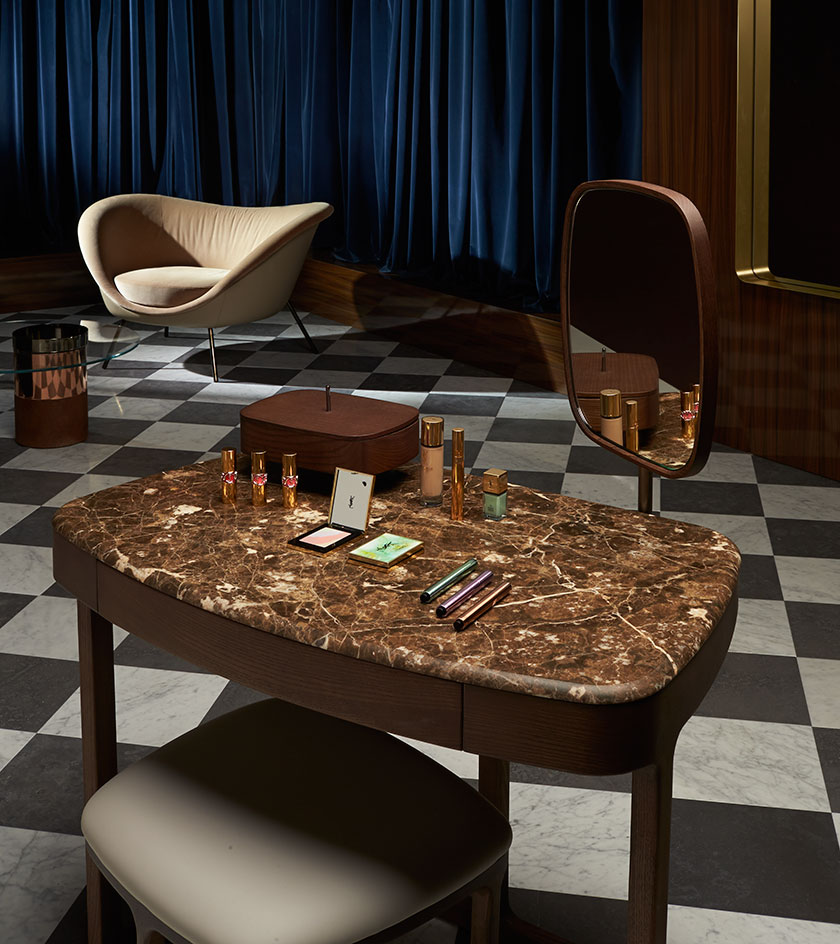
Best Powder Room
It’s hard to improve on perfection, but occasionally we need a touch-up
Mirror, mirror, on the wall – could the ‘Maskara’ coiffeuse be the fairest of them all? Designed by Emmanuel Gallina for Porada, this dandy dressing table has a bevelled marble top on a carefully crafted solid-ash frame, and can be supplied with a smart swivelling jewellery box and matching mirror. Mr DeMille, we’re ready for our close-up.
Pictured: ‘Maskara’ table, stool and mirror, from £4,324, by Emmanuel Gallina, for Porada. On table, Rouge Volupte Shine lipstick, £26 each; Gypsy Opale Face Palette, £42.50; Indie Jaspe Couture Palette, £42.50; Touche Éclat Foundation, £32.50; Luxurious Mascara, £25; La Laque Couture nail polish in Peace Green, £19; Touche Éclat Neutralisers in Apricot Bisque, Vert Green and Violet, £25, all by YSL Beauty. ‘Haumea’ coffee table, £1,260, by Massimo Castagna, for Gallotti & Radice. Armchair, £3,191, by Gio Ponti, for Molteni & C. ‘CYPRIS’ mirror, price on request, by Nina Mair, for ClassiCon, from aram. ‘Pao Fero Rosewood’ wallcovering, £32 per panel, by Abet Laminati. ‘Adamo & Eva’ fabric, £109 per m, by Dedar. ‘Chess’ honed limestone and marble flooring, from £72 per sq m, by Mandarin Stone
Photography: Matthew Donaldson; Writer: Christopher Stocks
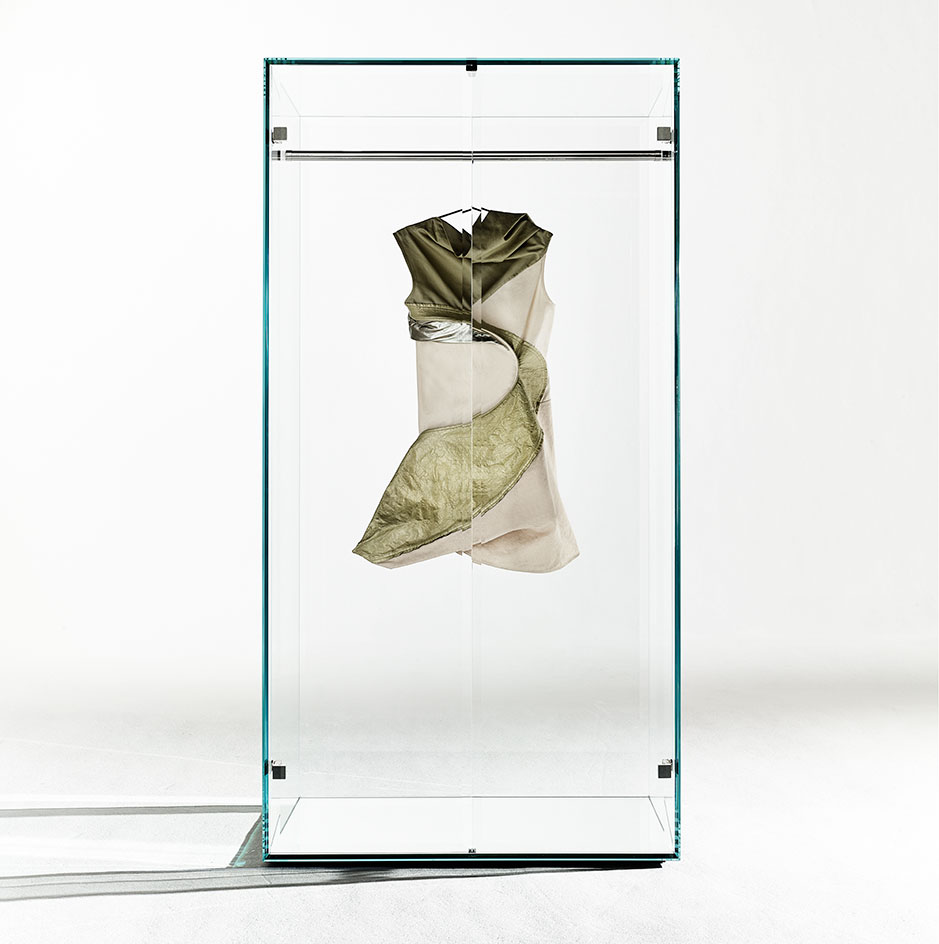
Best Public Hanging
‘Prism’ wardrobe, by Tokujin Yoshioka, for Glas Italia
We have to admit we almost looked right past Tokujin Yoshioka’s ‘Prism’ wardrobe for Glas Italia at the 2015 edition of Salone del Mobile. As much a display case as a hanging space, the Japanese designer’s transparent wardrobe is solely composed of tempered and thermo-welded glass, with 12mm-thick panels expertly bevelled to refract light. Here, the sartorial spotlight is firmly set on its contents (in this case, a piece from Rick Owens’ sculptural S/S 2016 collection), which hang from a polished steel rail. This exhibitionist’s treasure chamber certainly takes the guesswork out of outfit planning.
‘Prism’ wardrobe, from £6,366, by Tokujin Yoshioka, for Glas Italia. Dress, £1,144, by Rick Owens
Photography: Paul Zak; Writer: Katrina Israel
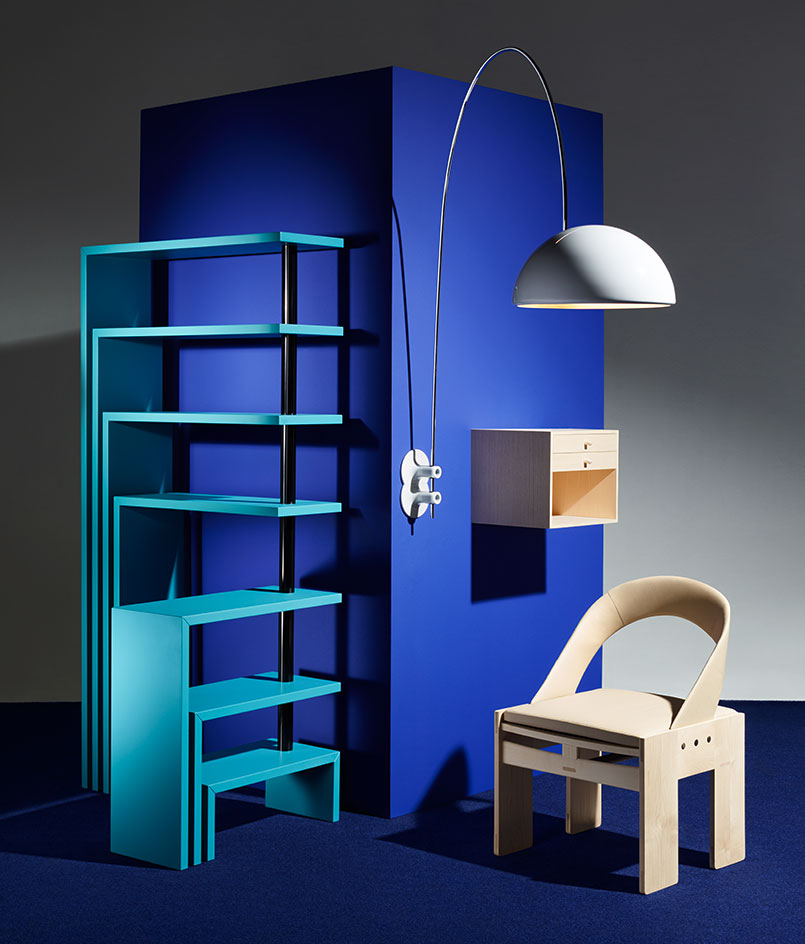
Best Reissues
Italy’s design champions are back at the top of the league with these updated classics
This year, iconic Italian design has made a comeback with a winning streak of reissues. Zanotta has created vibrant new hues (burgundy and dark blue-green) for Achille Castiglioni’s 1989 ‘Joy’ rotating bookshelf, while two Joe Colombo-designed pieces have been modernised. His original 1967 lighting for Oluce is now available as a wall version in a contemporary white finish, and his dynamic wall storage, revived by Danish brand Karakter, has been transformed from plastic to aluminium. As for Carlo Scarpa’s 1964 ‘618’ chair for Meritalia, it now comes in three new wooden finishes and luxurious leather upholstery.
Pictured from left, ‘JOY’ bookshelf, price on request, by Achille Castiglioni, for zanotta, from Simon Cook Agencies. ‘CoupÉ 1159/R’ lamp, from €1,176, by Joe Colombo, for Oluce. ‘Il Kilometre’ wall storage, £235, by Joe Colombo, for Karakter Copenhagen. ‘618‘ chair, €2,100, by Carlo Scarpa, for Meritalia. ‘Ultra Blue 264’ limited-edition paint, £49 for 2.5 litres, by Little Greene. ‘Devonia plain’ carpet in Town Blue, £41 per sq m, by Axminster carpets
Photography: Michael Bodiam; Writer: Sujata Burman
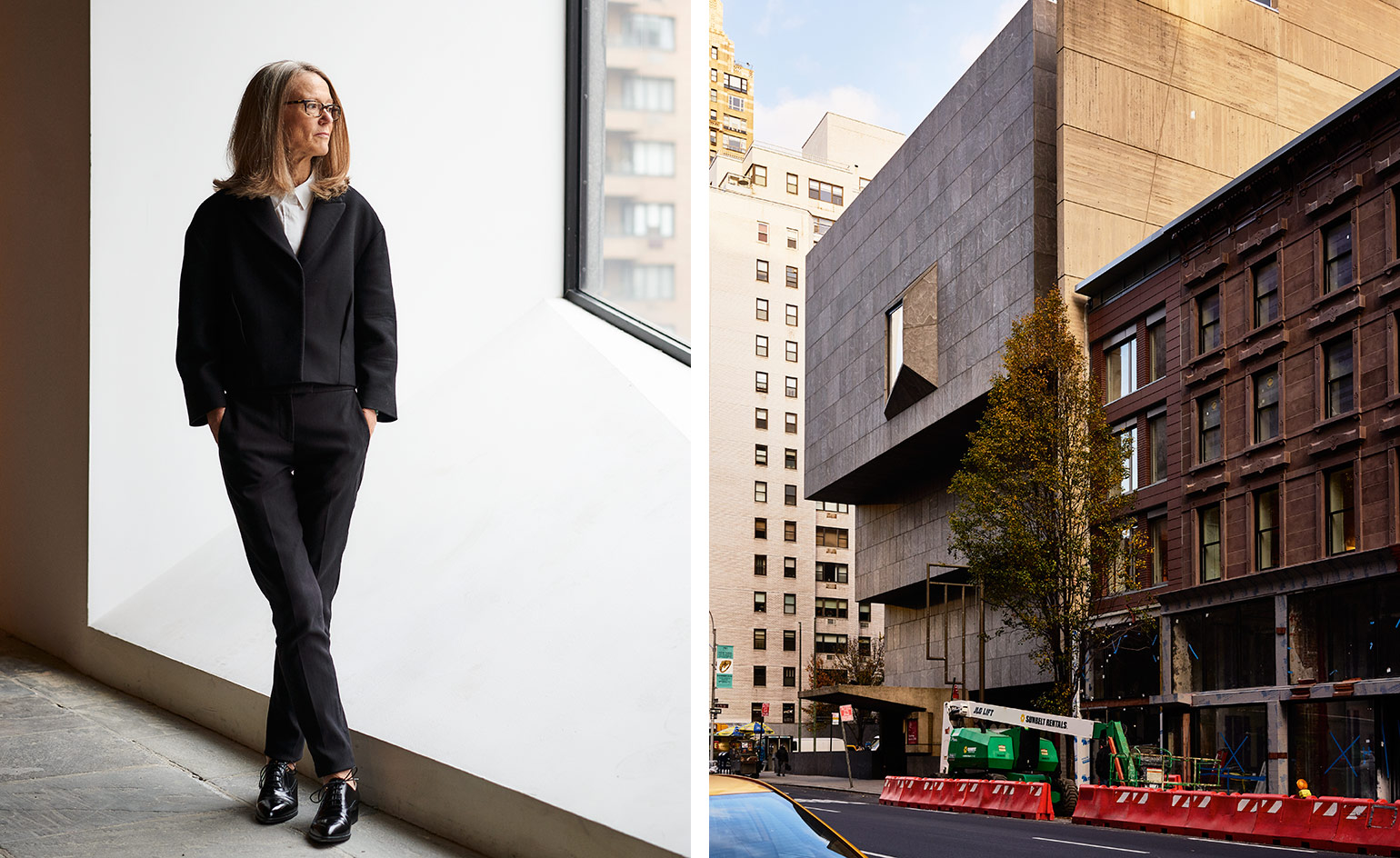
Best Reboot
The Met Breuer, New York
Most buildings cannot escape the awkwardness of transition. Stripped roughly on moving day, they are typically left echoing and vulnerable, littered with vestiges of past relevance and then made freshly chaotic by renovation. Marcel Breuer’s inverted pyramid, on the corner of New York’s Madison Avenue and 75th Street, takes change in its stride. Even bustling with workers, studded with ladders and tarpaulin, and free of its modular internal walls, the five-storey, flame-treated grey granite structure retains a friendly, beautifully proportioned readiness. On 18 March, the former home of the Whitney Museum of American Art will reopen to the public as The Met Breuer. Read more here.
Pictured: the trapezoidal window and stepped-back facade of the met breuer, whose modern art department is headed up by Sheena Wagstaff (left)
Photoraphy: Adrian Gaut; Writer: Stephanie Murg
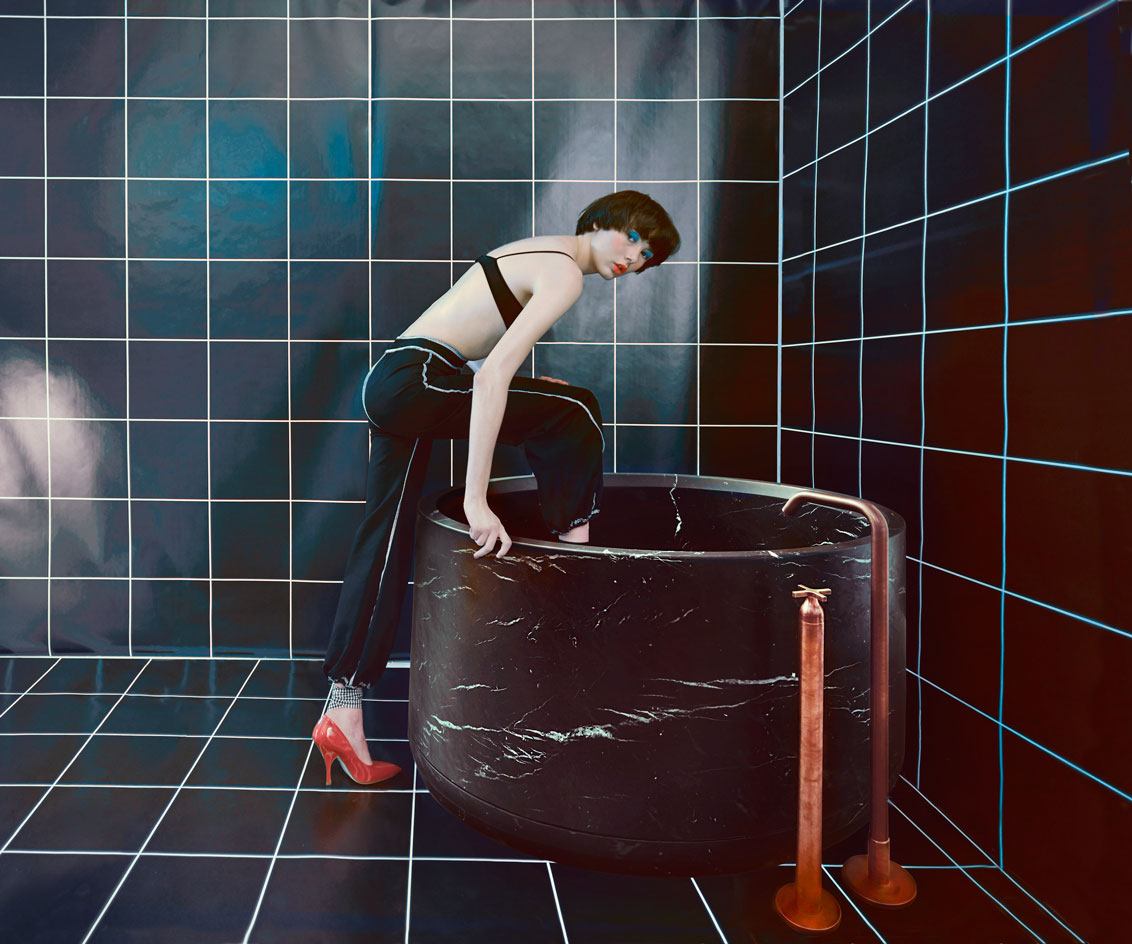
Best Soak
‘In-Out’ black marble bathtub, by Agape
Part washing apparatus, part sculpture, this futuristic update of Agape’s circular ‘In-Out’ bath is carved from smooth Nero Marquina. The tub’s precise lines contrast with the marble’s soft veins, creating a monumental monolith that gives a refined elegance to an everyday function. A freestanding copper tap adds a rich, industrial contrast.
Pictured: ‘In-Out’ marble bath, price on request, by Benedini Associati, for Agape, Bra £450; trousers, £395, both by JW Anderson. Shoes, £645, by Miu Miu
Photography: Pierpaolo Ferrari; Writer: Rosa Bertoli
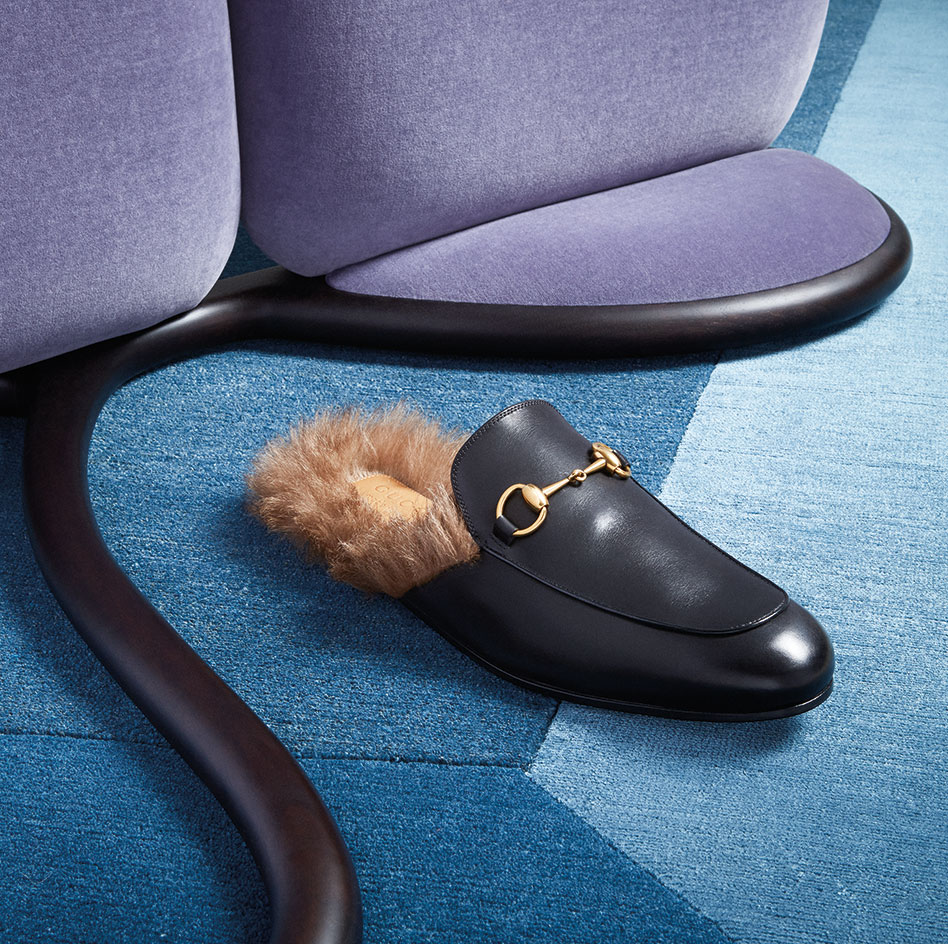
Best Soft Landing
Fur-lined slippers, by Gucci
Comfort is not usually a consideration for the fashion pack, making Alessandro Michele’s kangaroo fur-lined black leather slipper a surprise shoe of the year. Repurposing Gucci’s signature horsebit loafer, the unisex hybrid made its debut on Michele’s A/W 2015 men’s runway, his first season for the brand. Michele’s eclecticism had taken hold: business in the front, fun in the back, the mullet shoe was born and sold, sold, sold. ‘Princeton’ slippers, £680, by Gucci
Pictured: Part slipper, part loafer, the trans-seasonal ‘Princeton’, with its breezy open back and toasty toe, has been quickly adopted by fashion industry stalwarts best soft furnishings ‘Bergère 30’ armchair, €5,332, by Jaime Hayon, for Ceccotti Collezioni. ‘Dipped Frame’ rug, €4,717, by CC Tapis
Photography: Leonardo Scotti; Writer: Katrina Israel
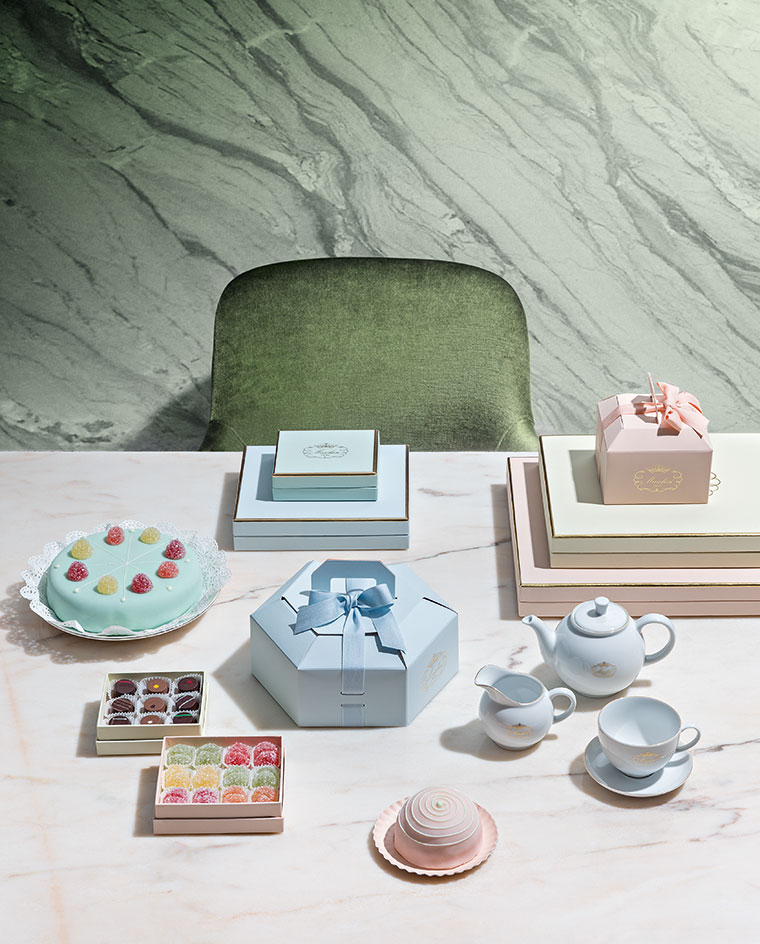
Best Sweet Treats
Afternoon tea, by Pasticceria Marchesi
Since Pasticceria Marchesi opened its second location last autumn, on Milan’s via Montenapoleone, it’s now possible, for the first time in the shop’s 192-year-long history, to sit down to enjoy its pastries, chocolates, bonbons and other sweet treats, all freshly made on the premises; the original location had always been standing room only. Perched on velvet armchairs, you can savour Milan’s best merende (afternoon snacks) with coffee or tea served in a unique Rosenthal porcelain service. Takeaway comes in the prettiest pastel-coloured packaging.
Pictured: At the new pasticceria marchesi, with its green marble walls, velvet chairs and marble-top tables, goodies include, clockwise from top left, Chantilly cake, price on request; box of 12 gumdrops, €21; box of 36 chocolates, €40; ribboned cake box; box of 64 gumdrops, €65; box of 100 chocolates, €100; teapot, €85; teacup and saucer, €65; milk jug, €55; single-portion Chantilly cake, price on request; box of 12 gumdrops, €21; box of nine chocolates, €18; ribboned cake box, all by Marchesi
Photography: Beppe Brancato; Writer: Nick Vinson
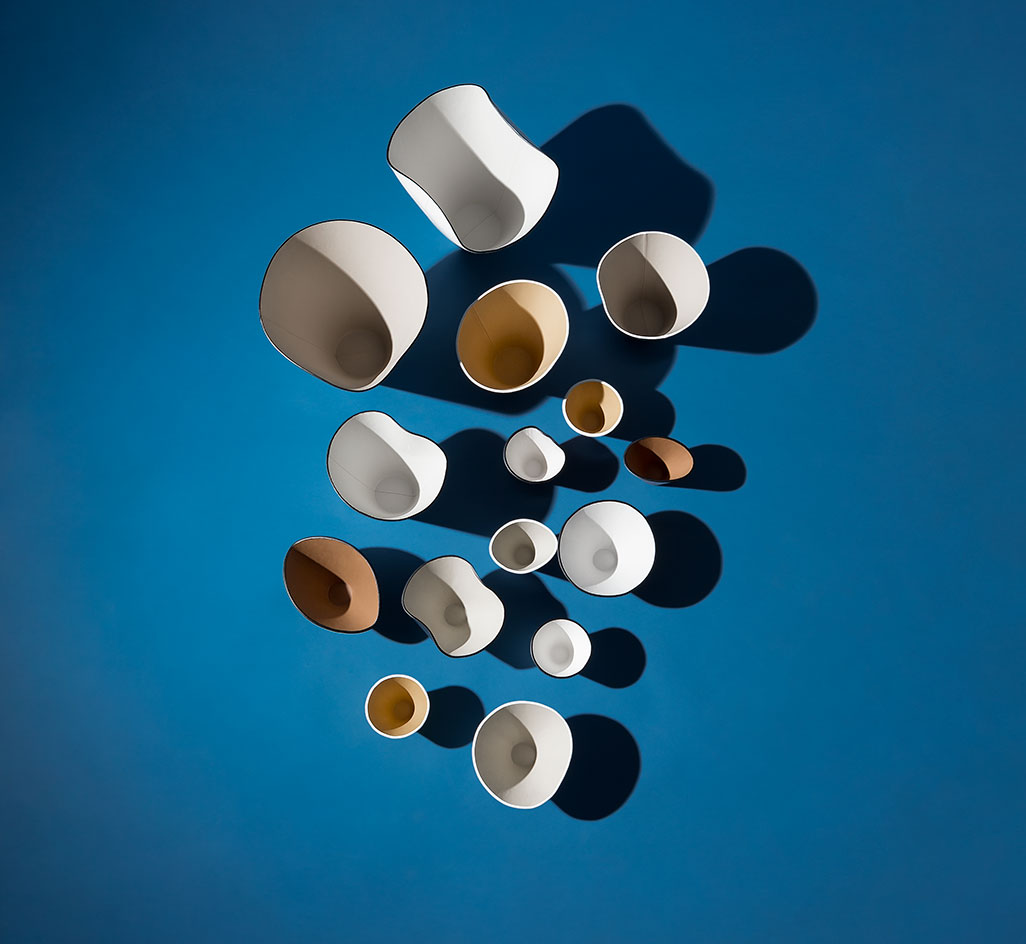
Best Tribute
The Bowls Project, by Jonathan Anderson, for Loewe
Taking inspiration from a series of conical bowls made in 1977 by Lucie Rie, one of the most important studio potters of the 20th century, Loewe creative director Jonathan Anderson has swapped clay for leather in his clever and respectful reinterpretation of her work. His three sets of 50 unique bowls, in colours adapted from Rie’s palette, including uranium yellow, are moulded and sculpted in double-faced calf leather, using Loewe’s artisanal techniques, and finished with a hand-painted edge. Leather bowls, from €450 to €1,400, by Jonathan Anderson, for Loewe, from WallpaperSTORE
Pictured: sculpted and moulded in leather, the bowls reference the forms and palette of austrian-born British Studio potter Lucie Rie, while showcasing Loewe’s artisanal skills
Photography: Beppe Brancato; Writer: Nick Vinson
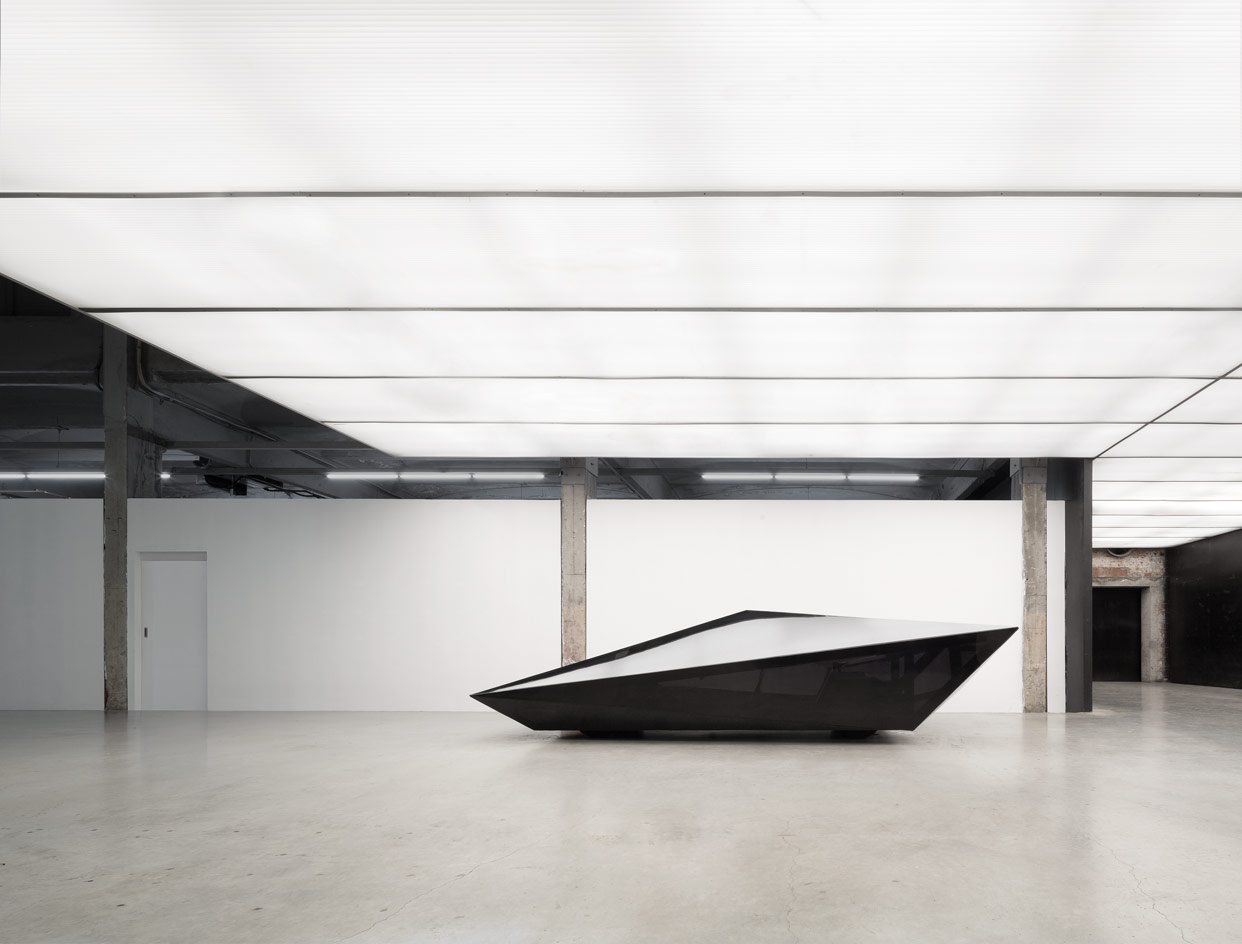
Best Wedge
Lo Res Car, by United Nude
Rem D Koolhaas has played with form since the launch of his avant-garde shoe brand, United Nude, in 2003. ‘We pushed boundaries and broke rules by not knowing them,’ admits Koolhaas (nephew of Rem senior, and also an architect). The studio’s new venture, into very bespoke transport design, is a similar case. This sinister-looking four-wheeled wedge began life as a 3D model of Lamborghini’s iconic Countach, gradually reduced in resolution until it was just a low-polygon abstract form. Following a non-running model built in 2010, Koolhaas has now created the first fully functional Lo Res Car. Smoked polycarbonate bodywork sits atop an angular steel frame on the guts of an electric golf cart. ‘We gave ourselves total freedom – it’s an art project,’ Koolhaas says. The entire body lifts to allow access to two inline seats, with minimal instruments and a hexagonal steering wheel. ‘Doors would ruin the purity,’ he explains. Look out for the car on the streets of LA, where the sole example is destined.
Pictured: The Lo-Res Car’s form results from lowering the resolution of aLamborghini Countach 3D model. The whole body lifts to give access to the interior. ‘Inside it’s raw and a bit retro science fiction,’ says Koolhaas
Photography: Liky Lam; Writer: Jonathan Bell
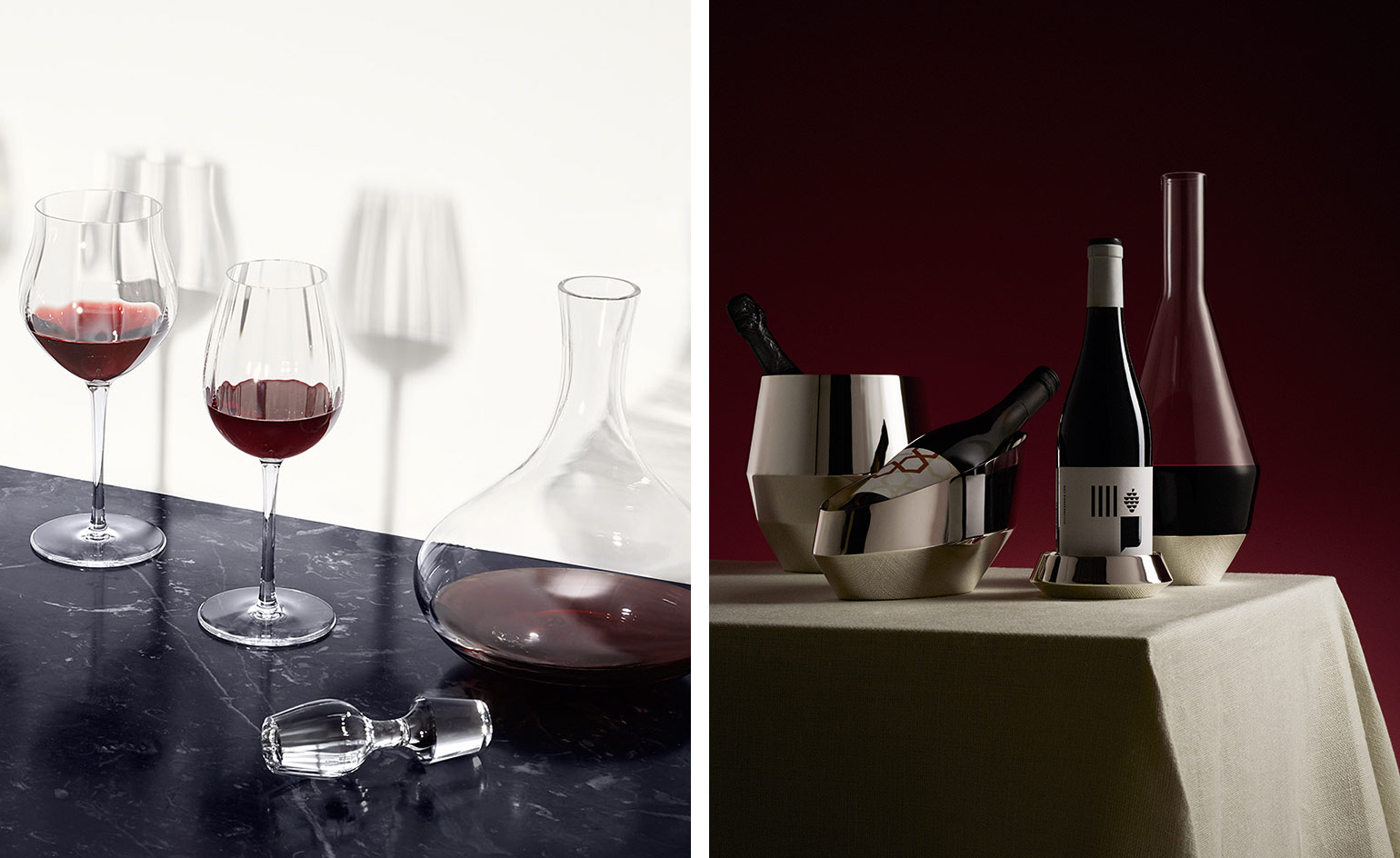
Best Wine and Design
Saint-Louis gives wine glasses a clever twist, while Puiforcat makes tasting totally tantalising
Twist 1586 collection, by Saint-Louis: Matching the right glass to the right drink is both easy and stylish thanks to Saint-Louis, whose Twist 1586 range takes the historic Venetian stripe pattern and gives it a new twist. Each piece in the collection (opposite), which also boasts an elegant decanter, has a subtly different design, with glasses for water, champagne, and young and mature wines. What really caught our eye is the way the pattern disappears once wine is poured into the glass.
Sommelier collection, by Michael Anastassiades and Enrico Bernardo, for Puiforcat: Designer Anastassiades, sommelier Bernardo and silversmith Puiforcat have created a set of exquisite accessories (this page) in mirror-polished silver plate and fine glass. As well as this striking champagne bucket, bottle holder, wine coaster and carafe, the range includes a water beaker and conical glasses – to concentrate the wine and slow the oxidation process – with weighty, silver-plated bases.
Pictured left: decanter, €450; bottle stopper, €90; MATURE-wine glass, €120; Champagne glass, €120; YOUNG-wine glass, €120; tumbler, €90, all part of the Twist 1586 collection, by Saint-Louis. Single Vineyard Clayvin Syrah 2012, £35 for 75cl, by Giesen. MCIII Brut001.14 Champagne, £330 for 75cl, by Moêt & Chandon. Estones de Mishima 2014, price on request, by Estones. Right: ‘Sommelier’ champagne bucket, €2,100; bottle holder, €1,350; bottle coaster, €430; carafe, €1,100, all by Michael Anastassiades and Enrico Bernardo, for Puiforcat, from wallpaperstore*. Right: from left, Dom Pérignon Björk And Chris Cunningham Edition Blanc, 2006, £145, from Harrods. Jamsheed Beechworth Roussanne, 2013, £24.50, label by Cloudy Co, from Berry Bros & Rudd. Celler Masroig Castell de les Pinyeres, €9, label by Atipus, from Celler Masroig. ‘Bordeaux’ emulsion, £41 for 2.5 litres, by Zoffany
Photography: Gustav Almestål, John Short; Writers: Nick Vinson, Christopher Stocks
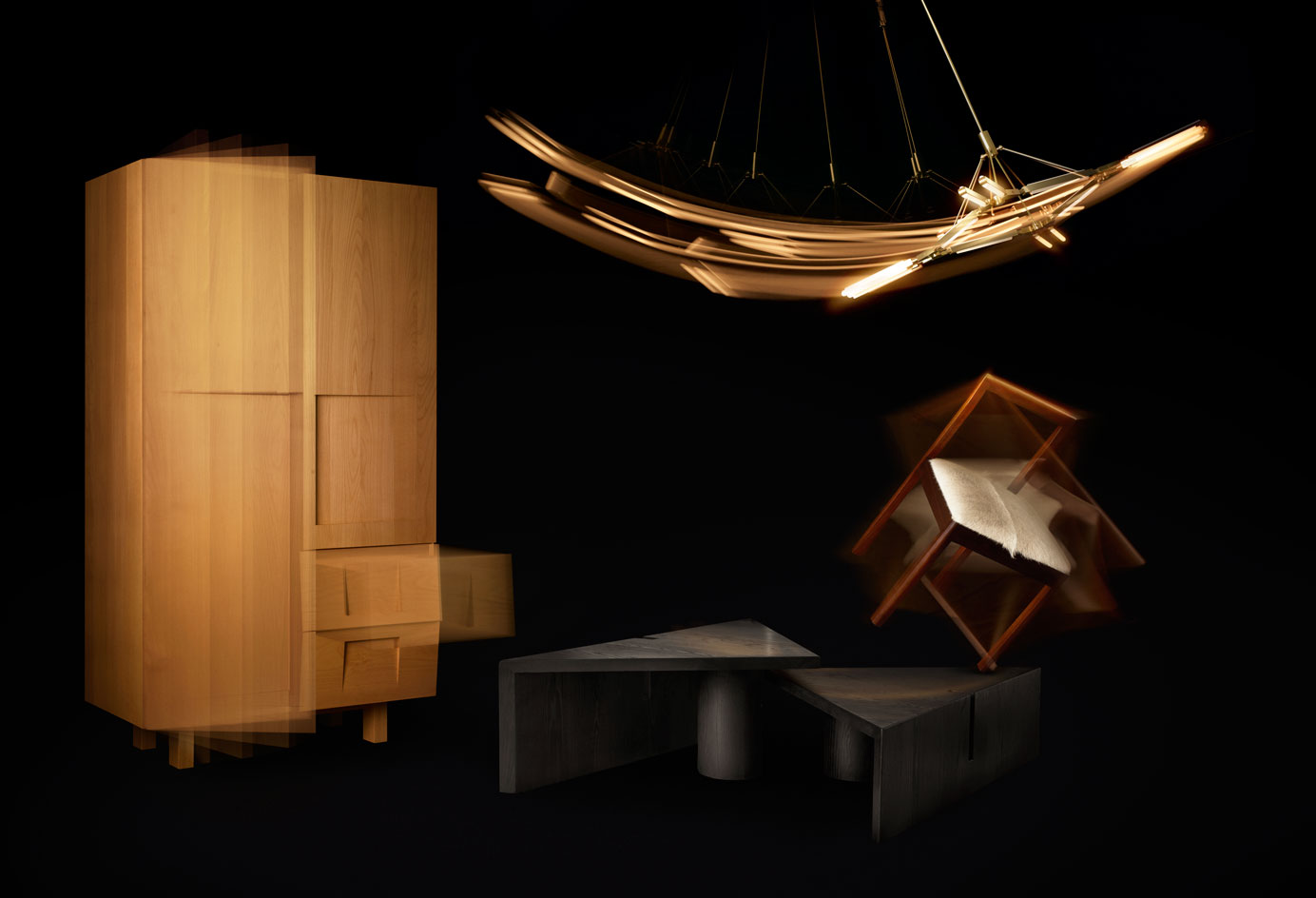
Best Young Americans
Four studios shaking the design world with hit after hit from their New York workshops
Pictured from left: Workstead: From lighting to hotel interiors, Workstead’s pared-back output transcends size and scope. Its thoughtful designs pay equal attention to form and function at the forefront; a case in point is this modular wardrobe with elegant inset andles. Wardrobe, price on request, by Workstead
Apparatus: This Manhattan studio’s captivating aesthetic is based on an experimental attitude towards materials. In 2015, founders Jeremy Anderson and Gabriel Hendifar expanded their offering to include marble vessels and furniture. ‘Portal’ table, $6,800, by Apparatus
Egg collective: Since starting Egg Collective in 2011, Stephanie Beamer, Crystal Ellis and Hilary Petrie have established a refined design language with a focus on natural materials and simple forms. The trio opened a swish Soho showroom in 2015. ‘Densen’ chair, $1,675, by Egg Collective
Pelle: In addition to giving small, everyday objects (such as soaps and candles) an ethereal, imaginative spin, Brooklyn-based husband and wife Oliver and Jean Pelle also gravitate towards architectural forms, as with this modular light.‘Pris Major’ light, $19,800, by Pelle
Photography: Anthony Cotsifas; Writer: Pei-Ru Keh
Receive our daily digest of inspiration, escapism and design stories from around the world direct to your inbox.
Rosa Bertoli was born in Udine, Italy, and now lives in London. Since 2014, she has been the Design Editor of Wallpaper*, where she oversees design content for the print and online editions, as well as special editorial projects. Through her role at Wallpaper*, she has written extensively about all areas of design. Rosa has been speaker and moderator for various design talks and conferences including London Craft Week, Maison & Objet, The Italian Cultural Institute (London), Clippings, Zaha Hadid Design, Kartell and Frieze Art Fair. Rosa has been on judging panels for the Chart Architecture Award, the Dutch Design Awards and the DesignGuild Marks. She has written for numerous English and Italian language publications, and worked as a content and communication consultant for fashion and design brands.
-
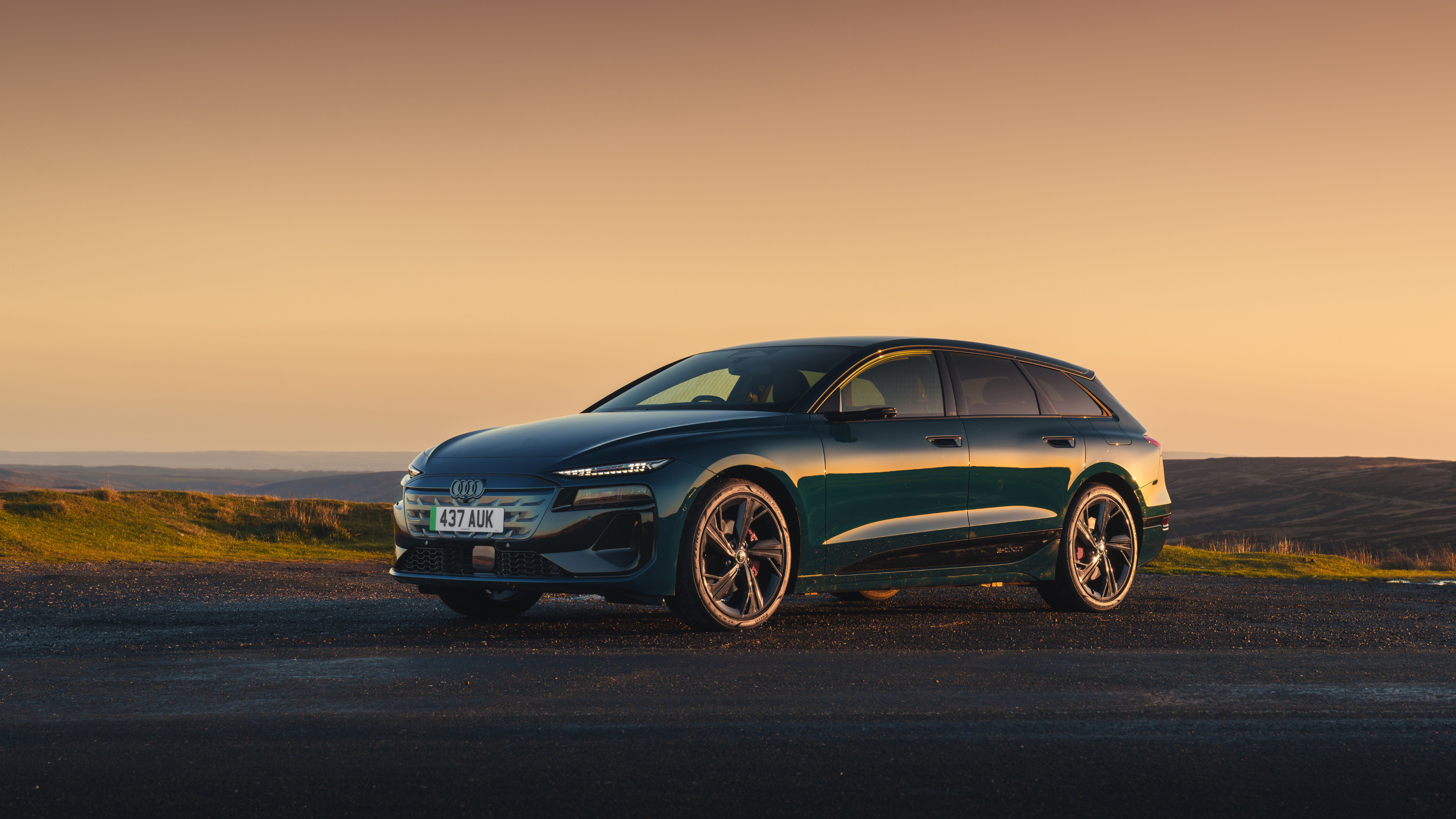 A tale of two Audis: the A5 saloon goes up against the A6 Avant e-tron
A tale of two Audis: the A5 saloon goes up against the A6 Avant e-tronIs the sun setting on Audi’s ICE era, or does the company’s e-tron technology still need to improve?
-
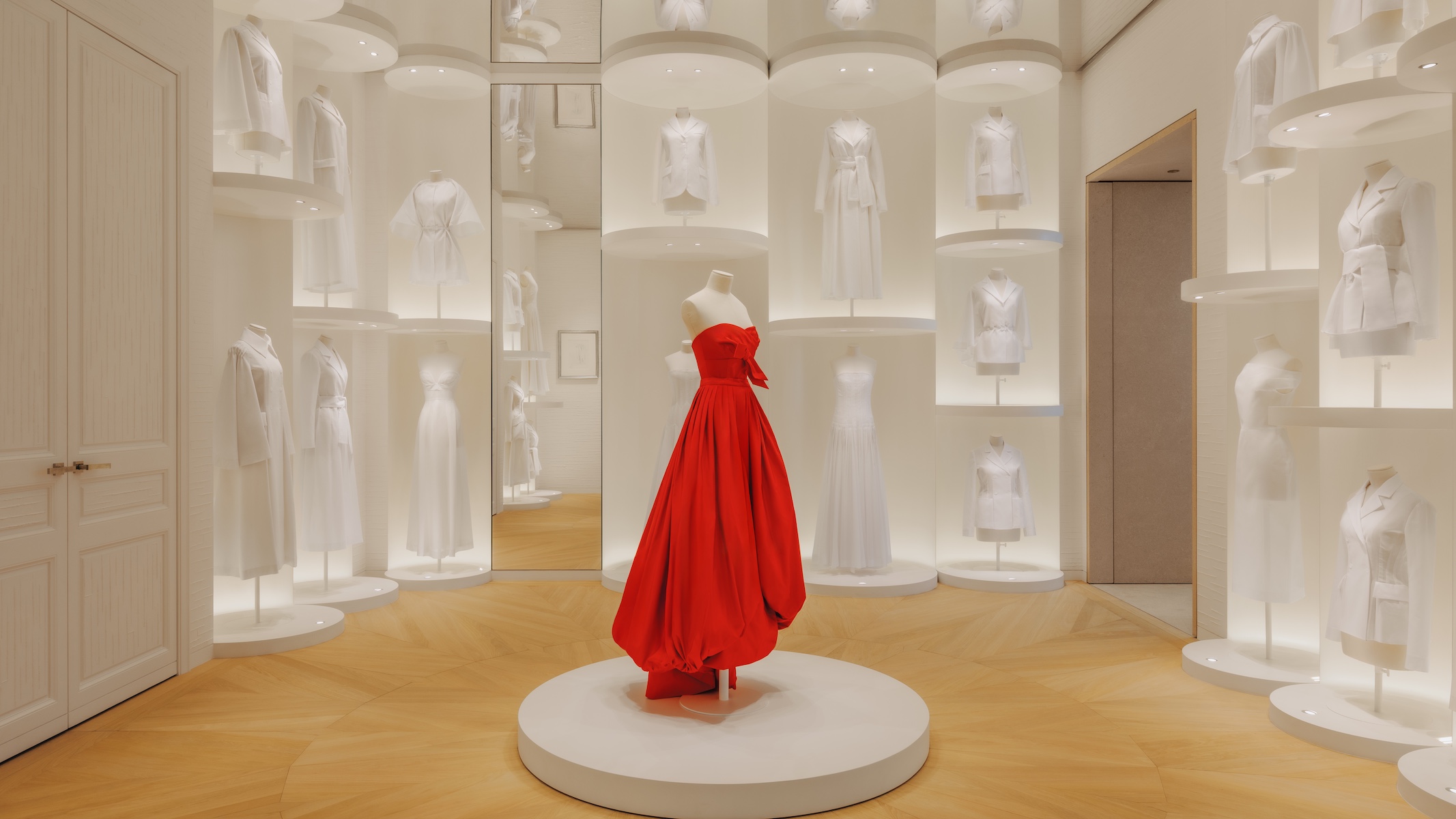 Inside Christian de Portzamparc’s showstopping House of Dior Beijing: ‘sculptural, structural, alive’
Inside Christian de Portzamparc’s showstopping House of Dior Beijing: ‘sculptural, structural, alive’Daven Wu travels to Beijing to discover Dior’s dramatic new store, a vast temple to fashion that translates haute couture into architectural form
-
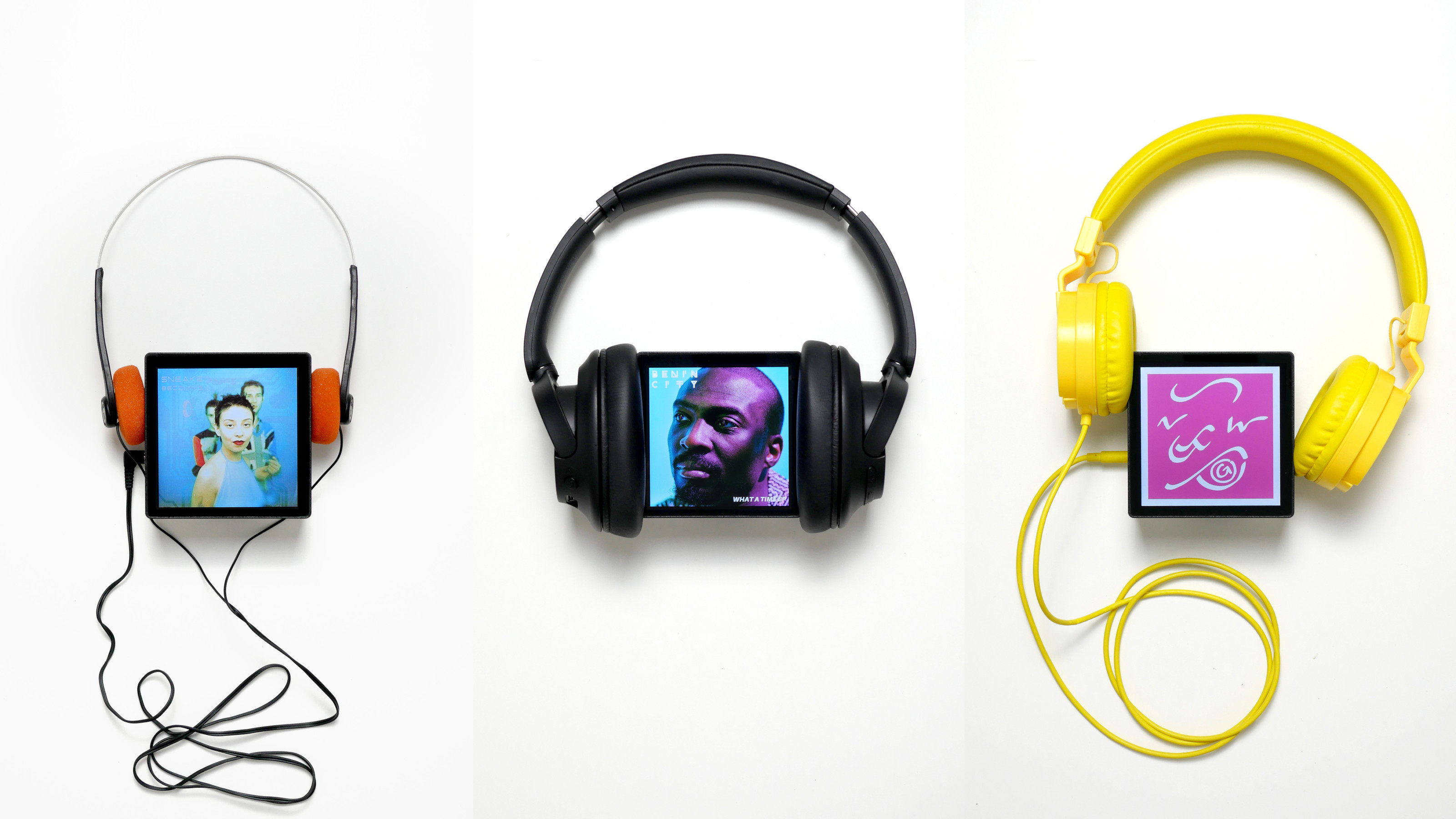 A music player for the mindful, Sleevenote shuns streaming in favour of focused listening
A music player for the mindful, Sleevenote shuns streaming in favour of focused listeningDevised by musician Tom Vek, Sleevenote is a new music player that places artist intent and the lost art of record collecting at the forefront of the experience